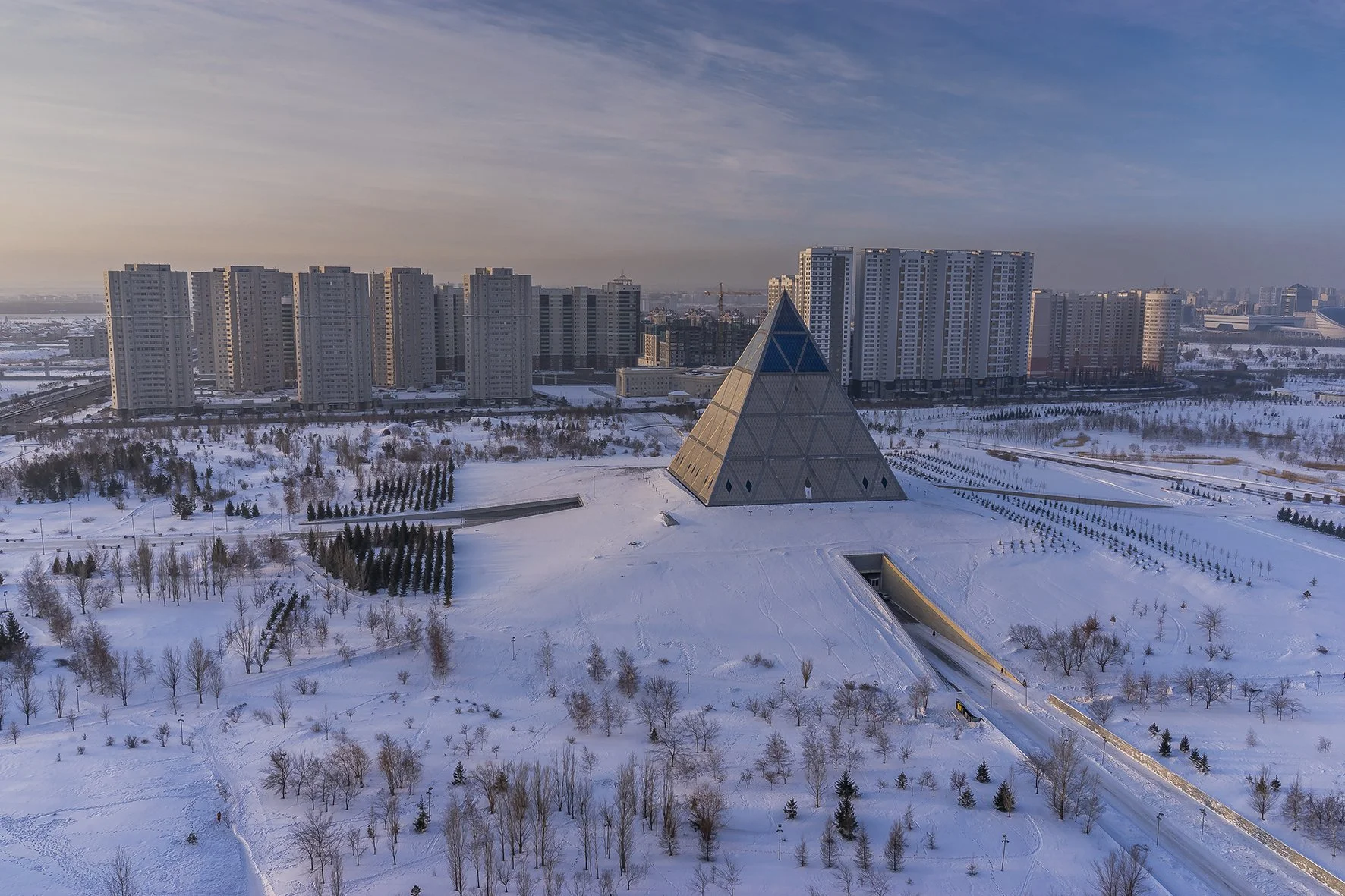

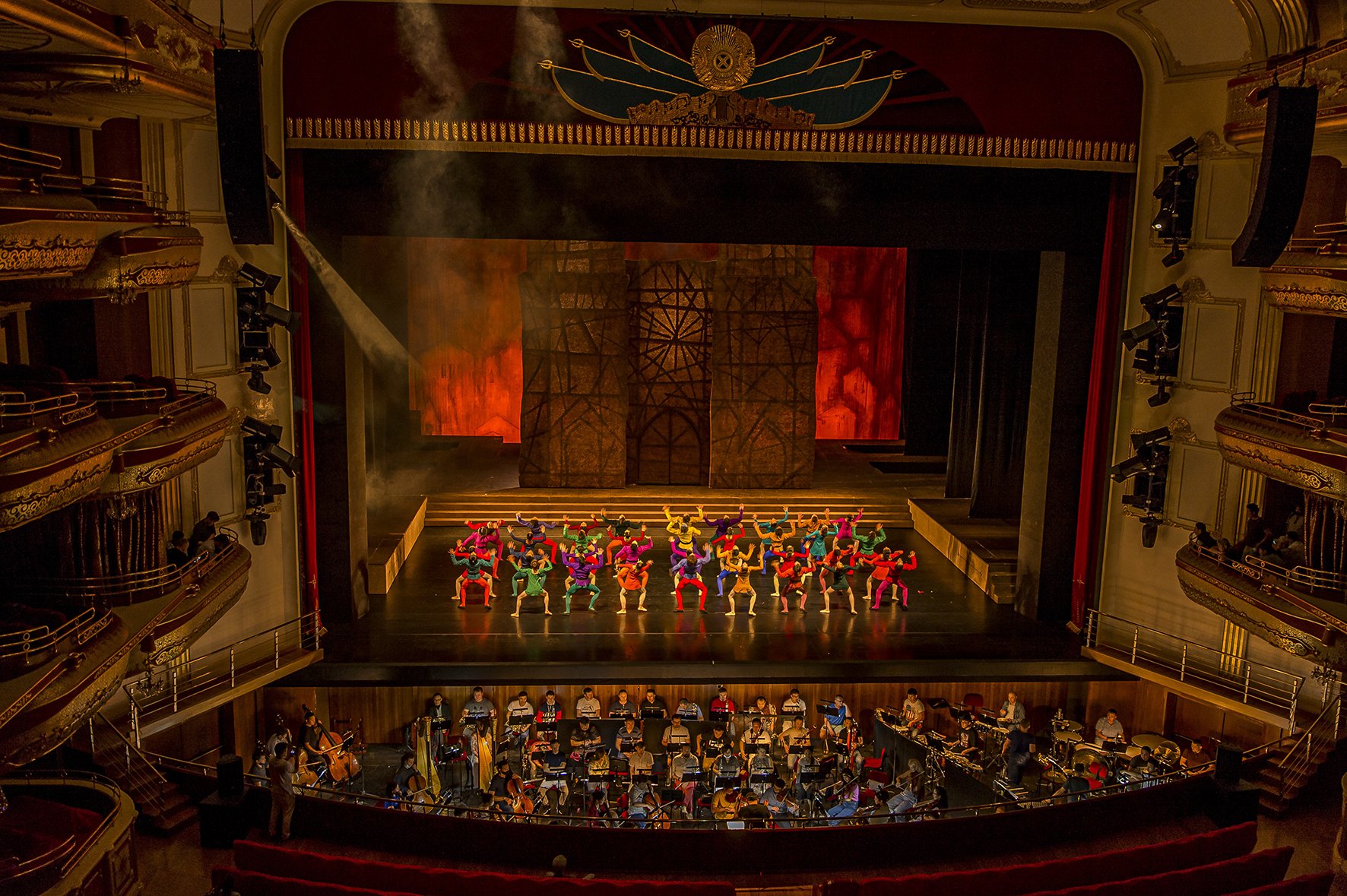


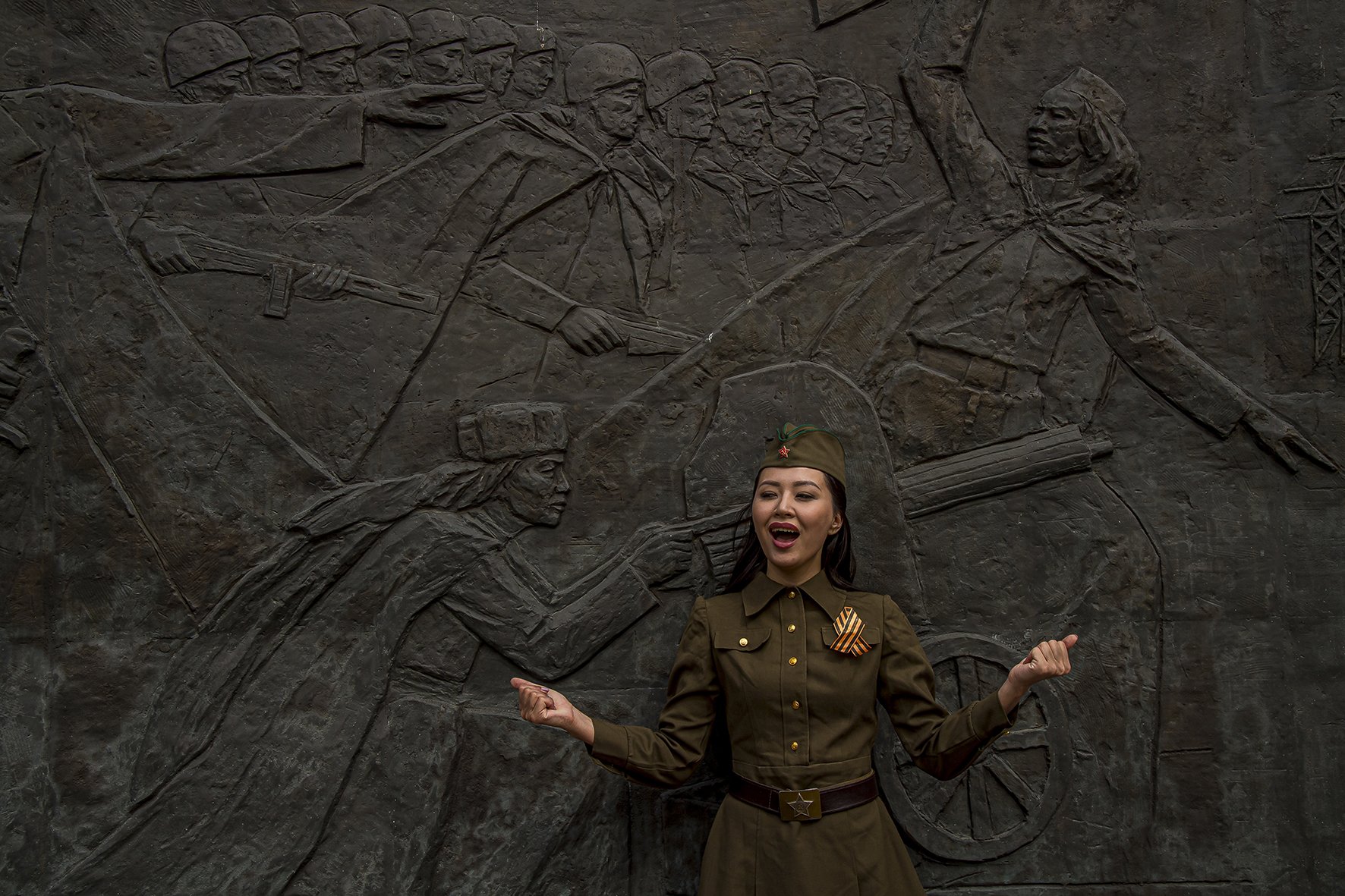



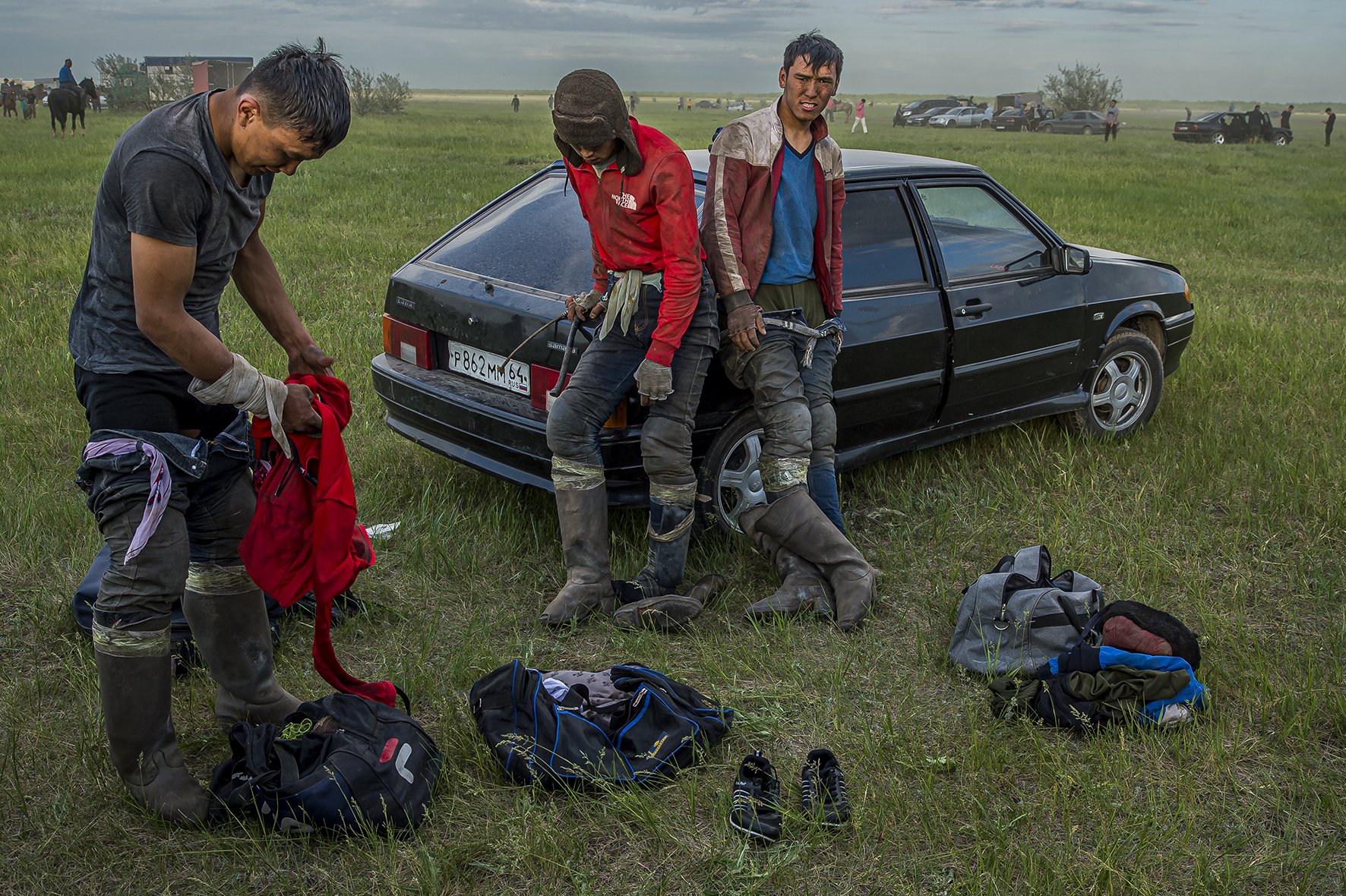
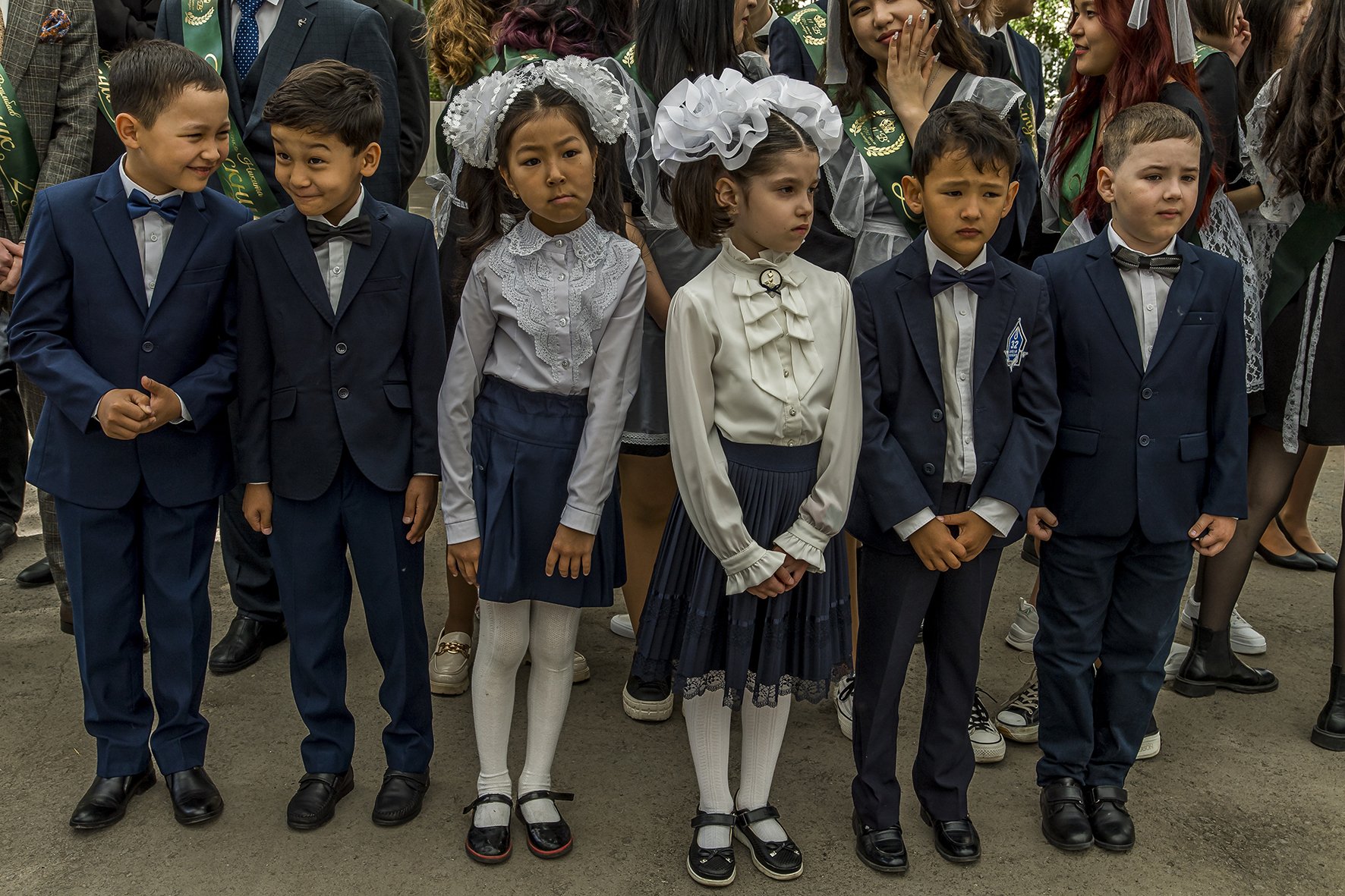
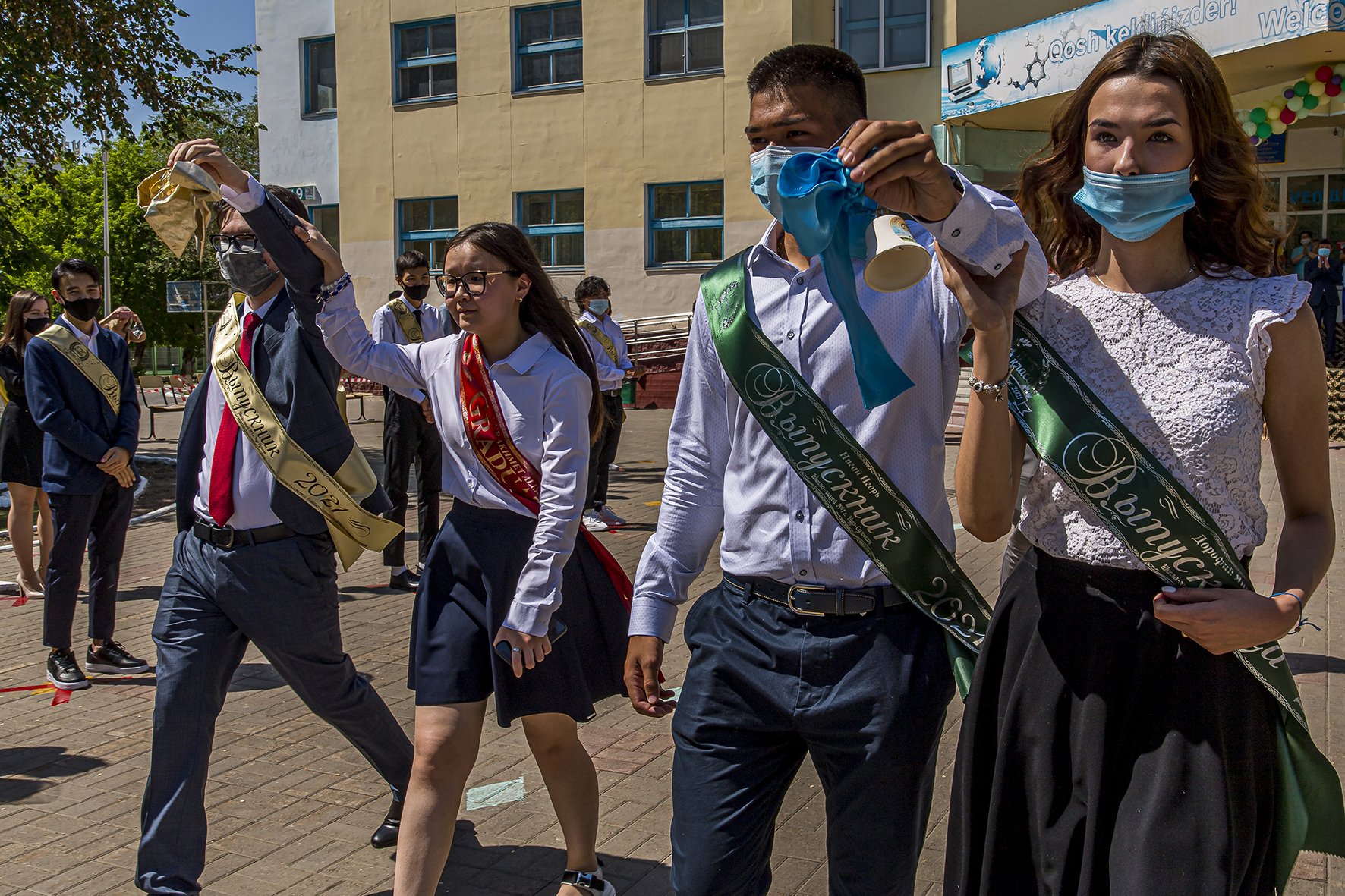
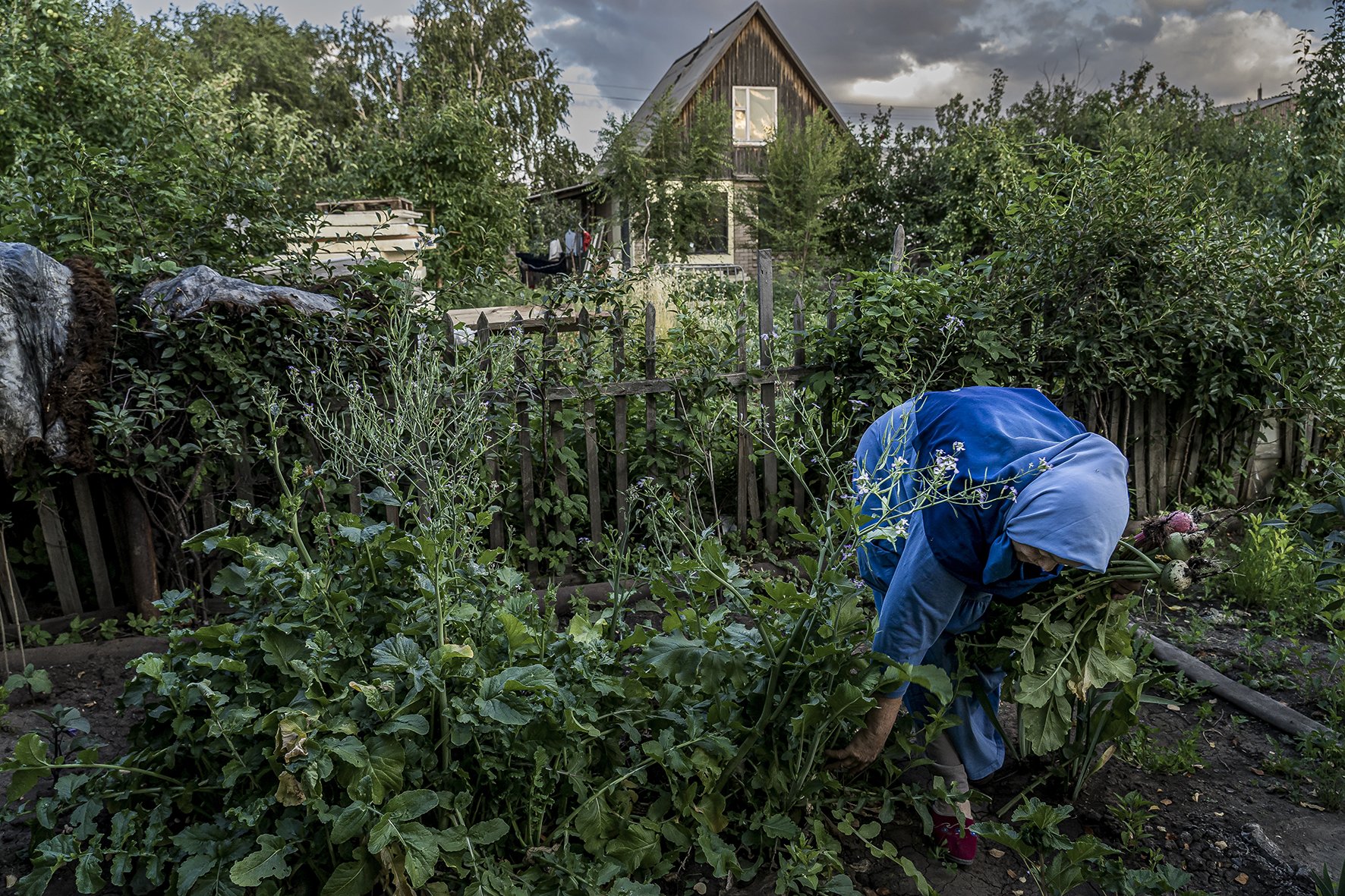

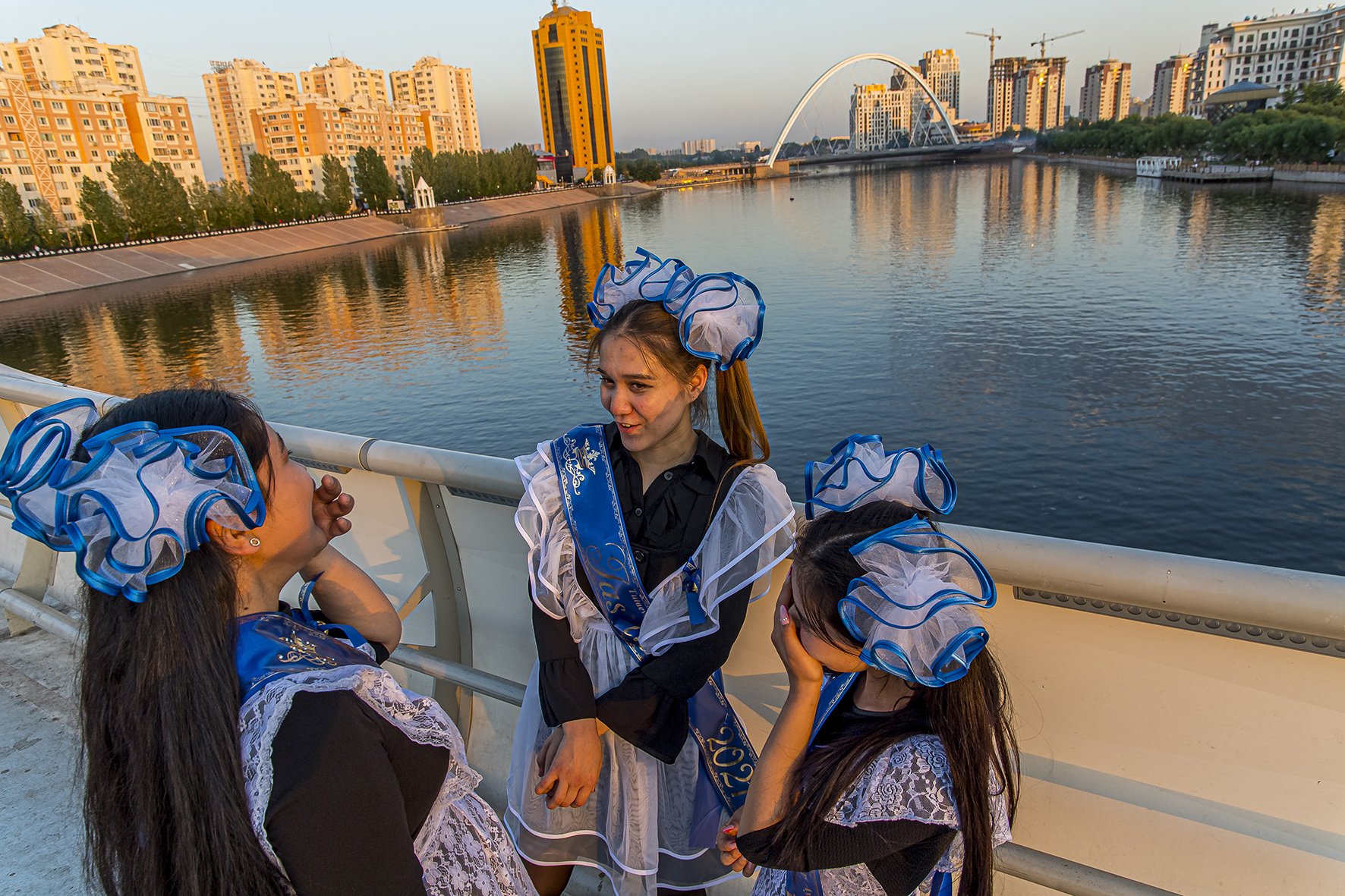
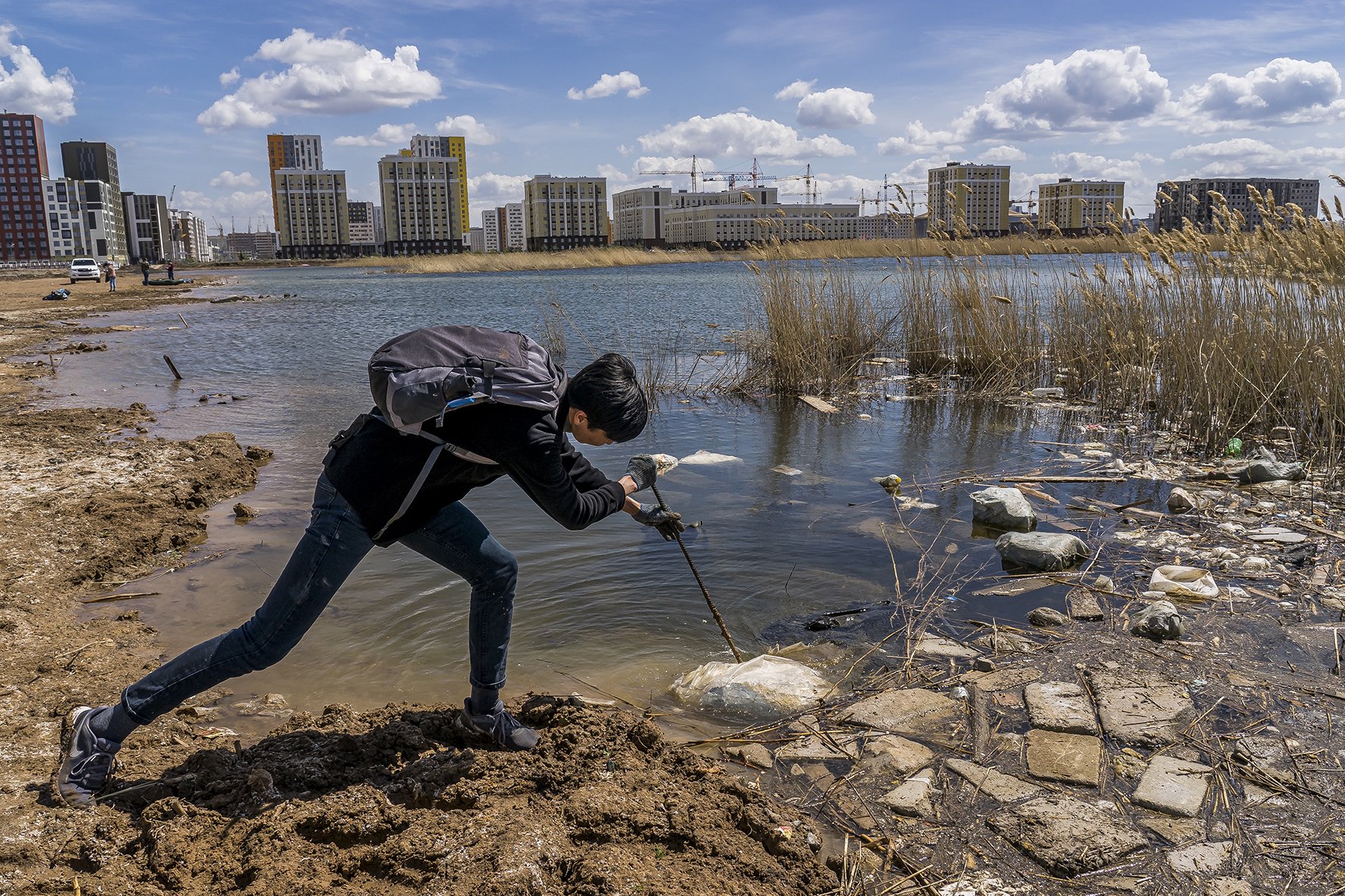

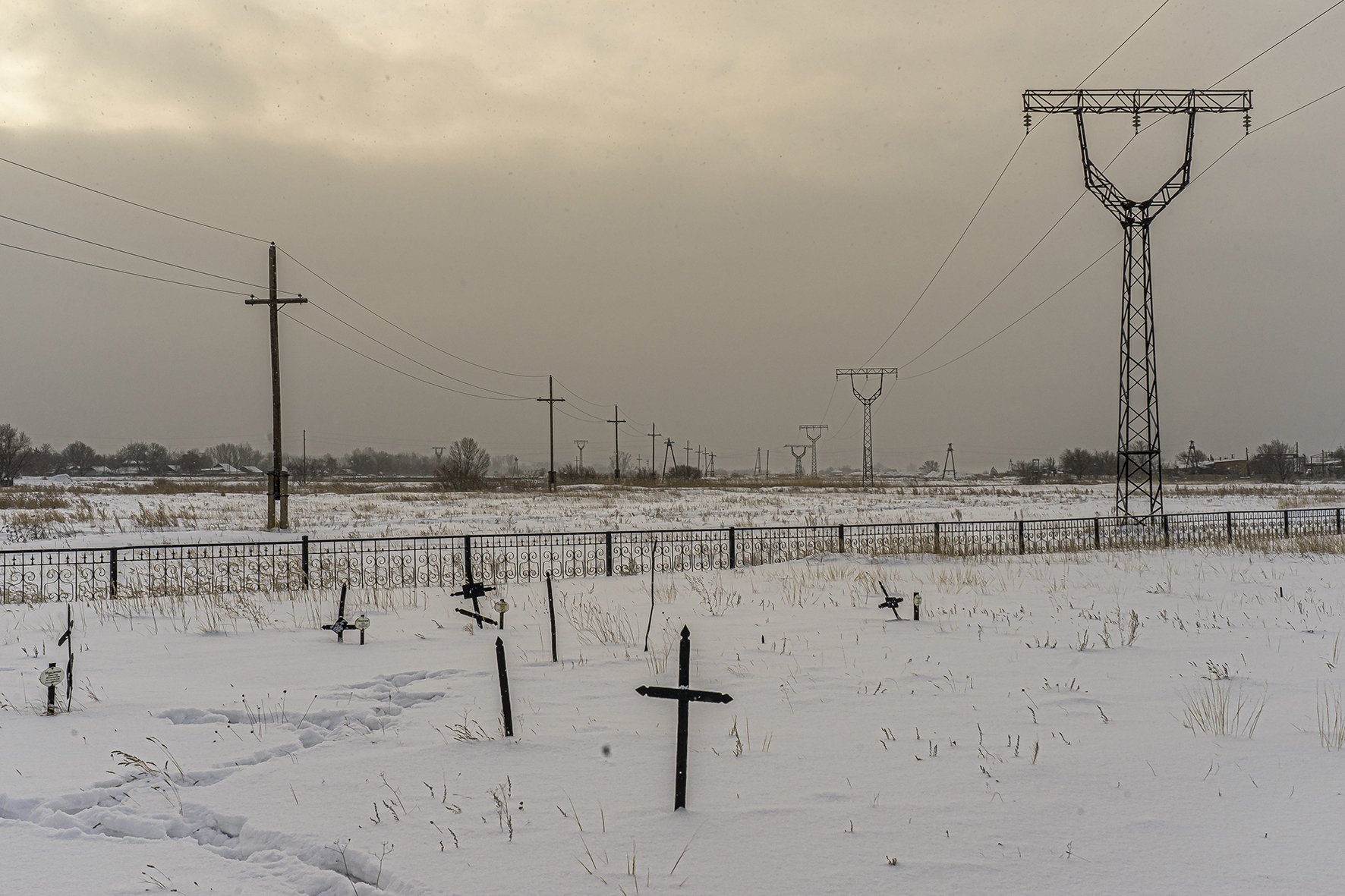



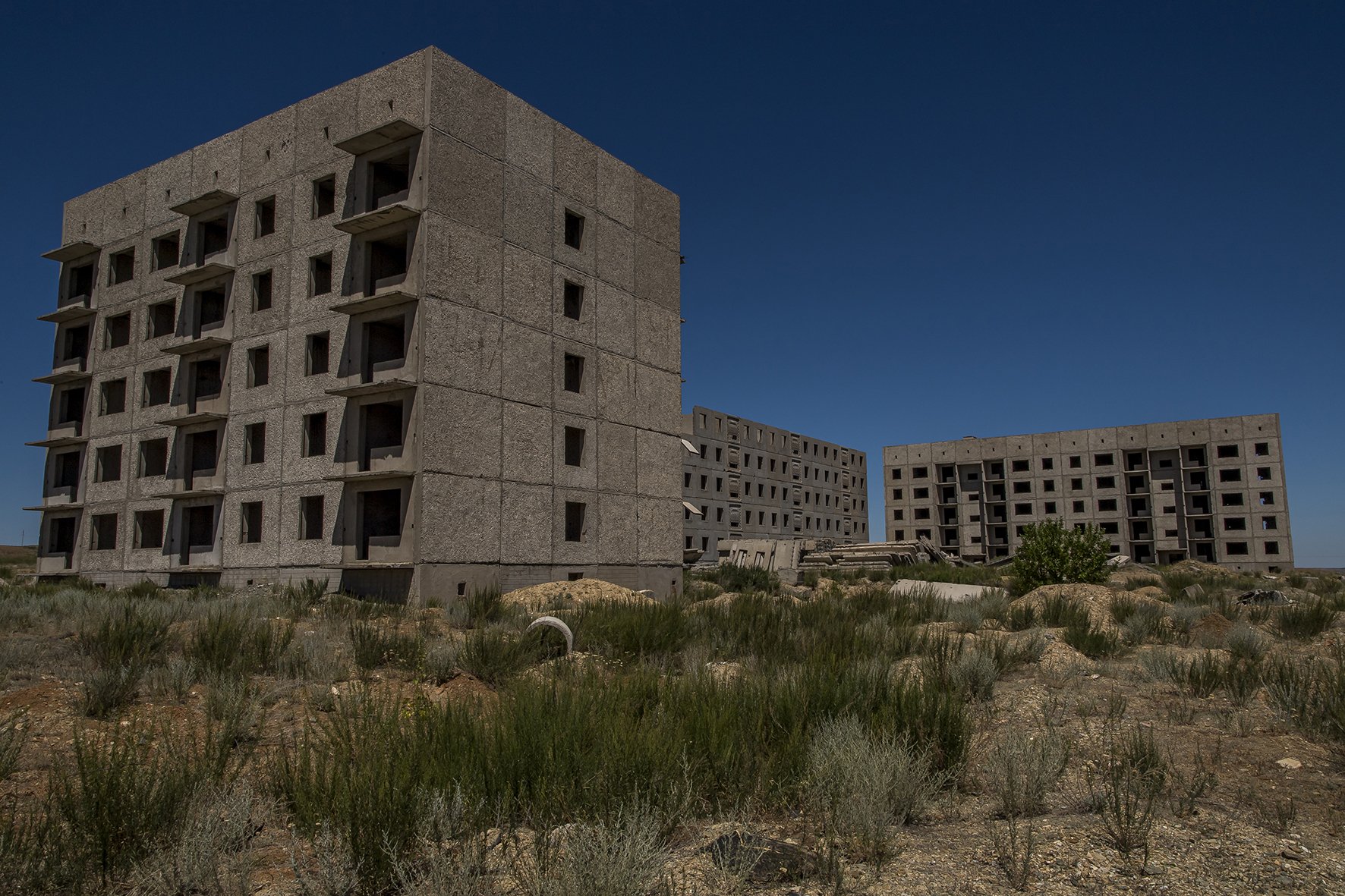

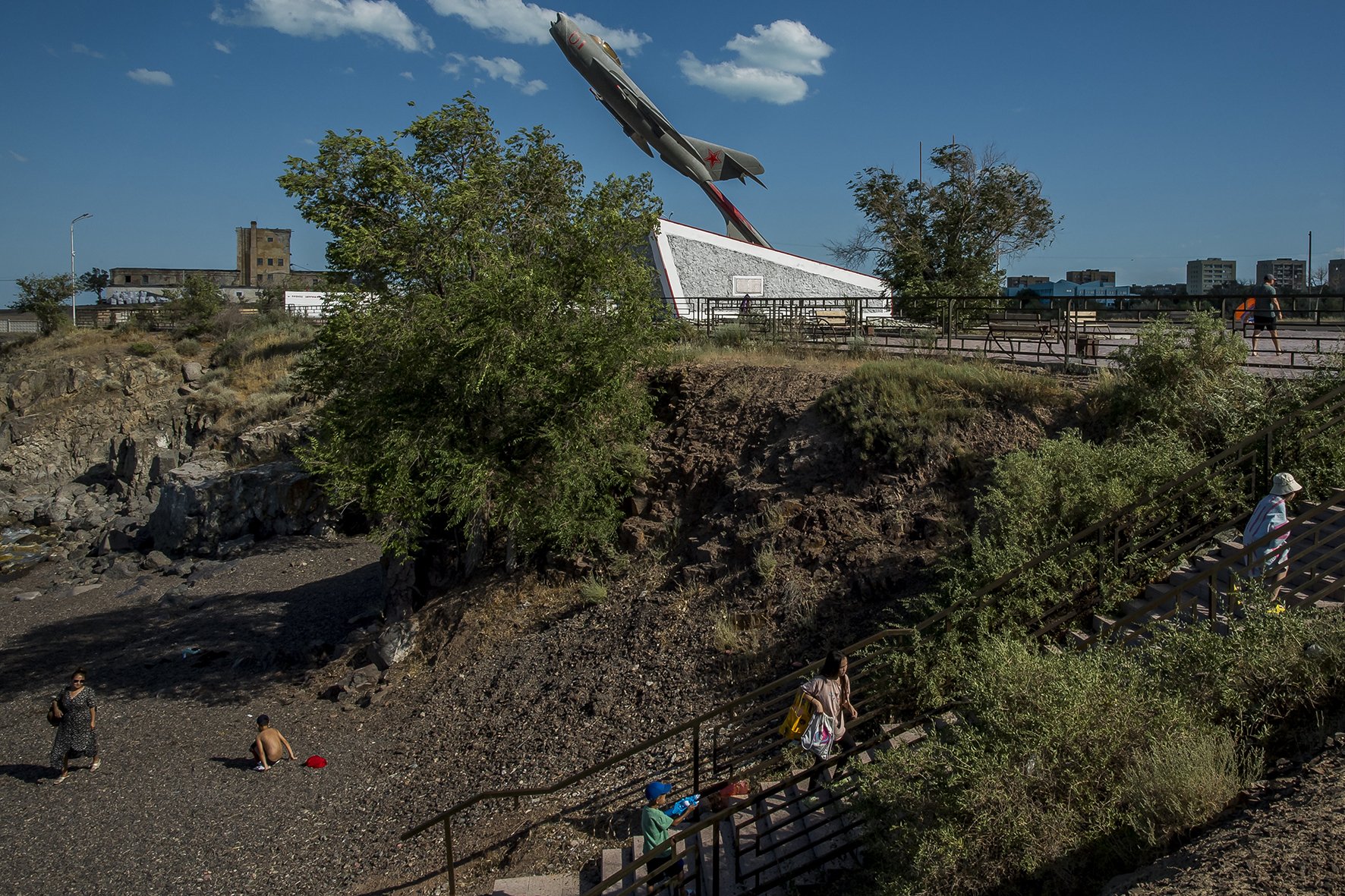


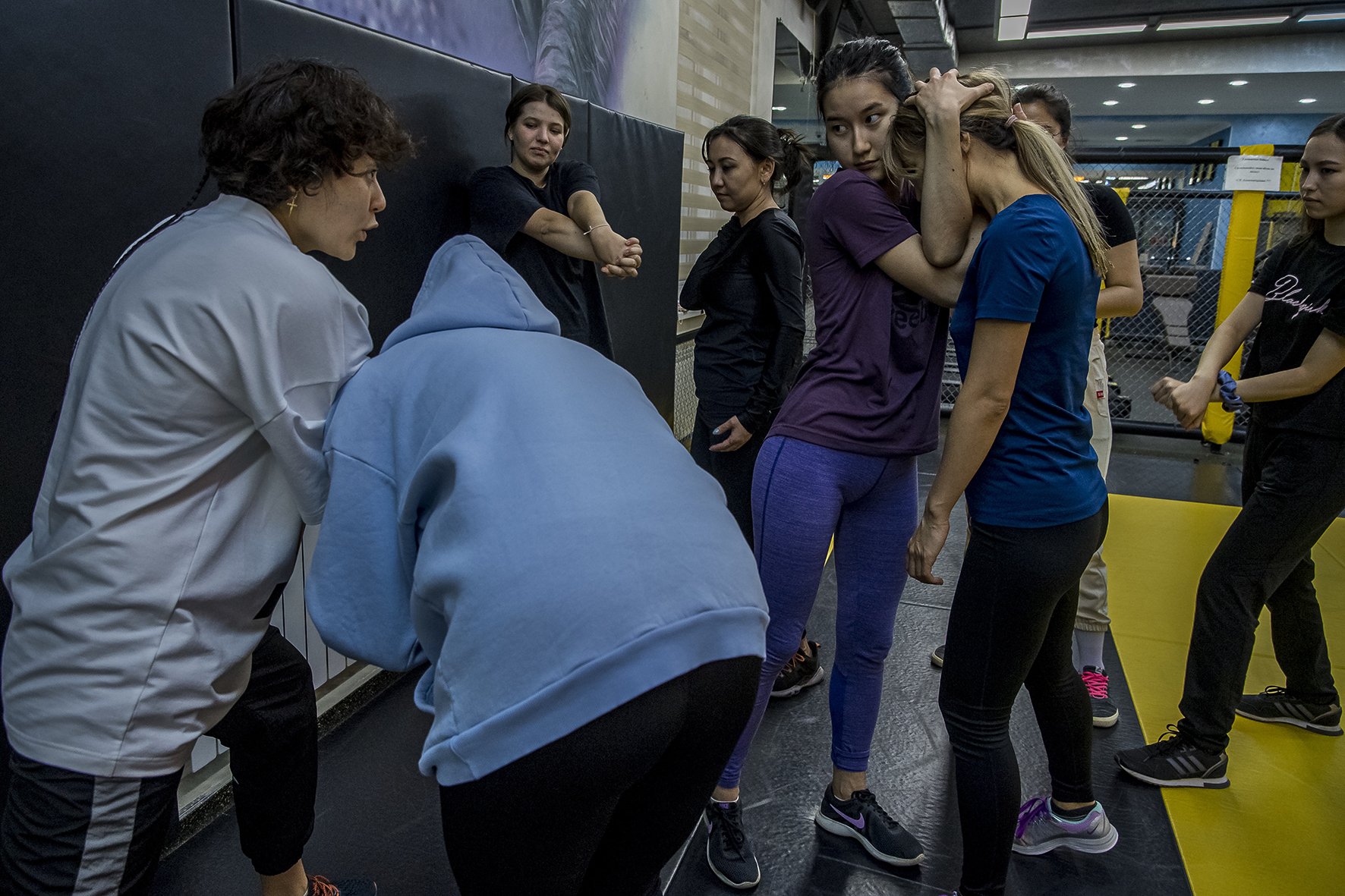

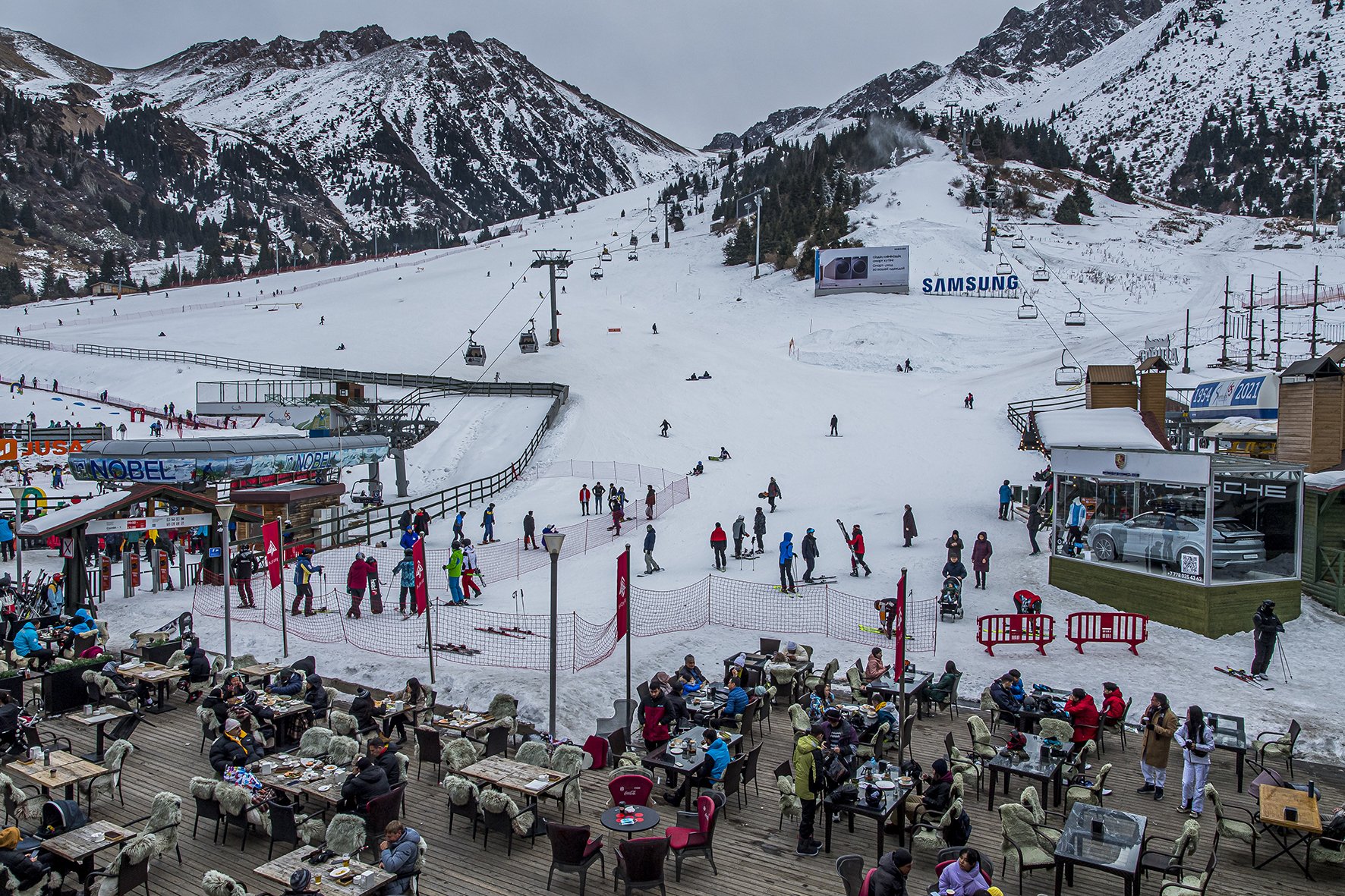

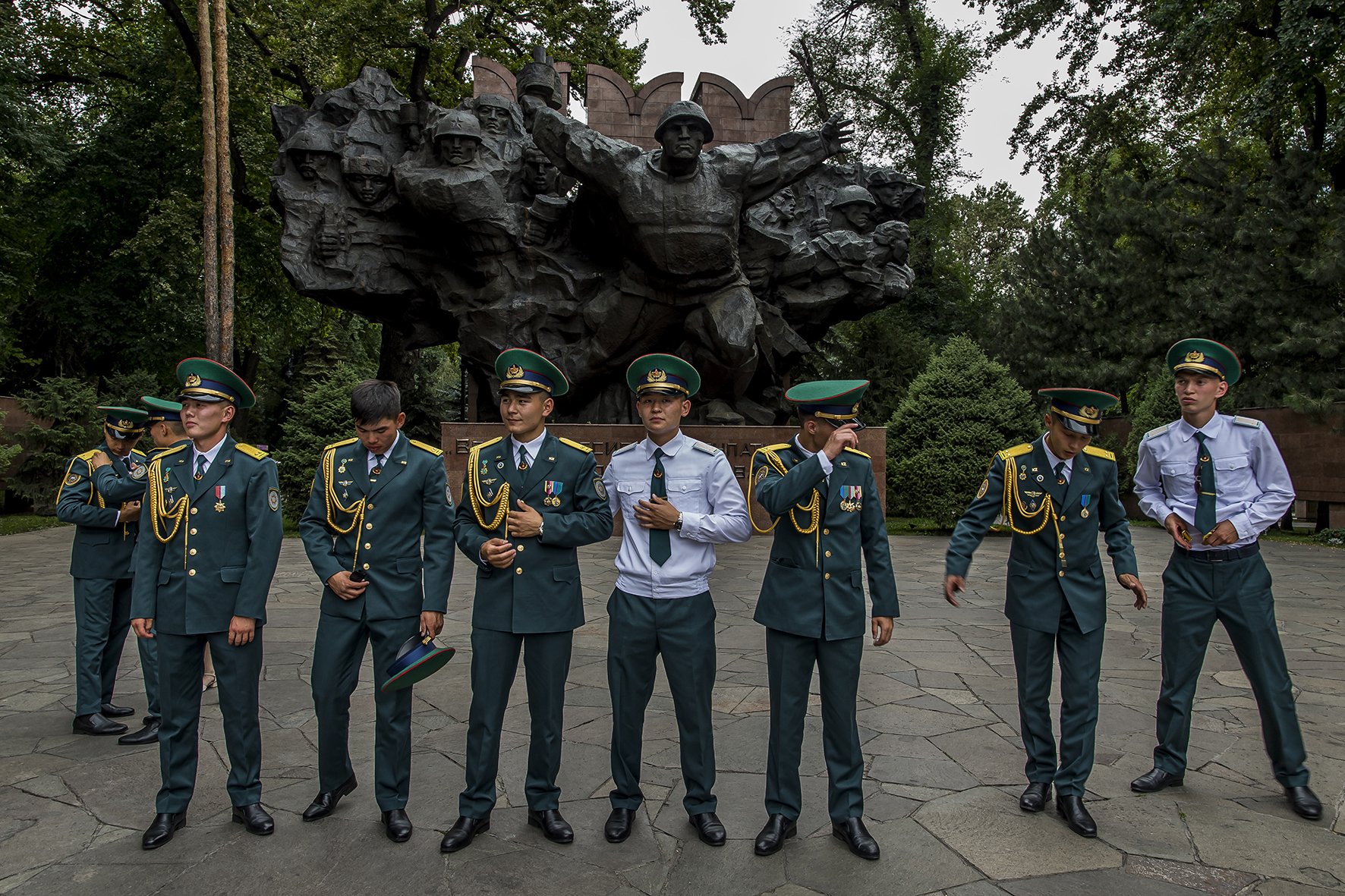
















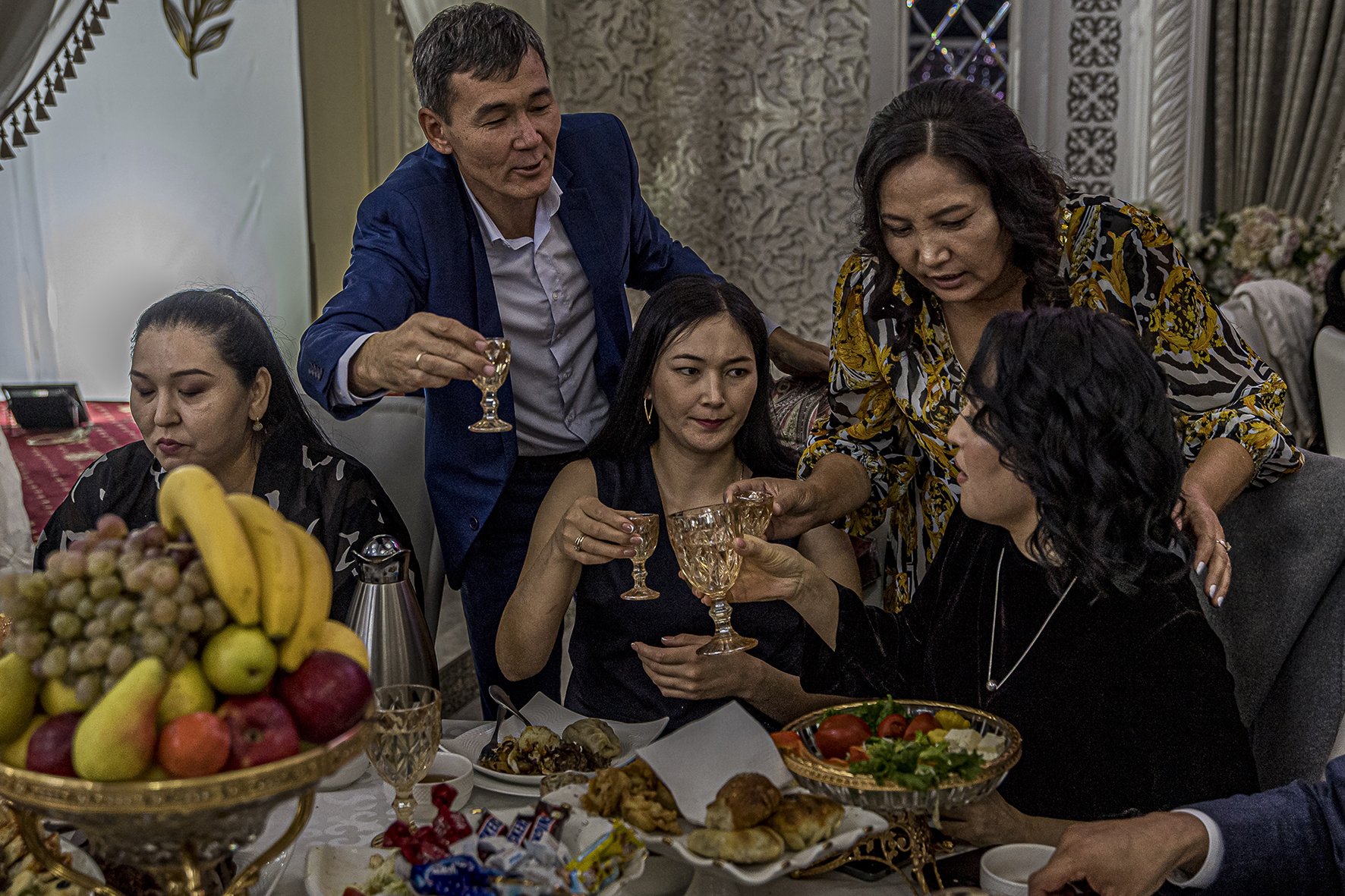


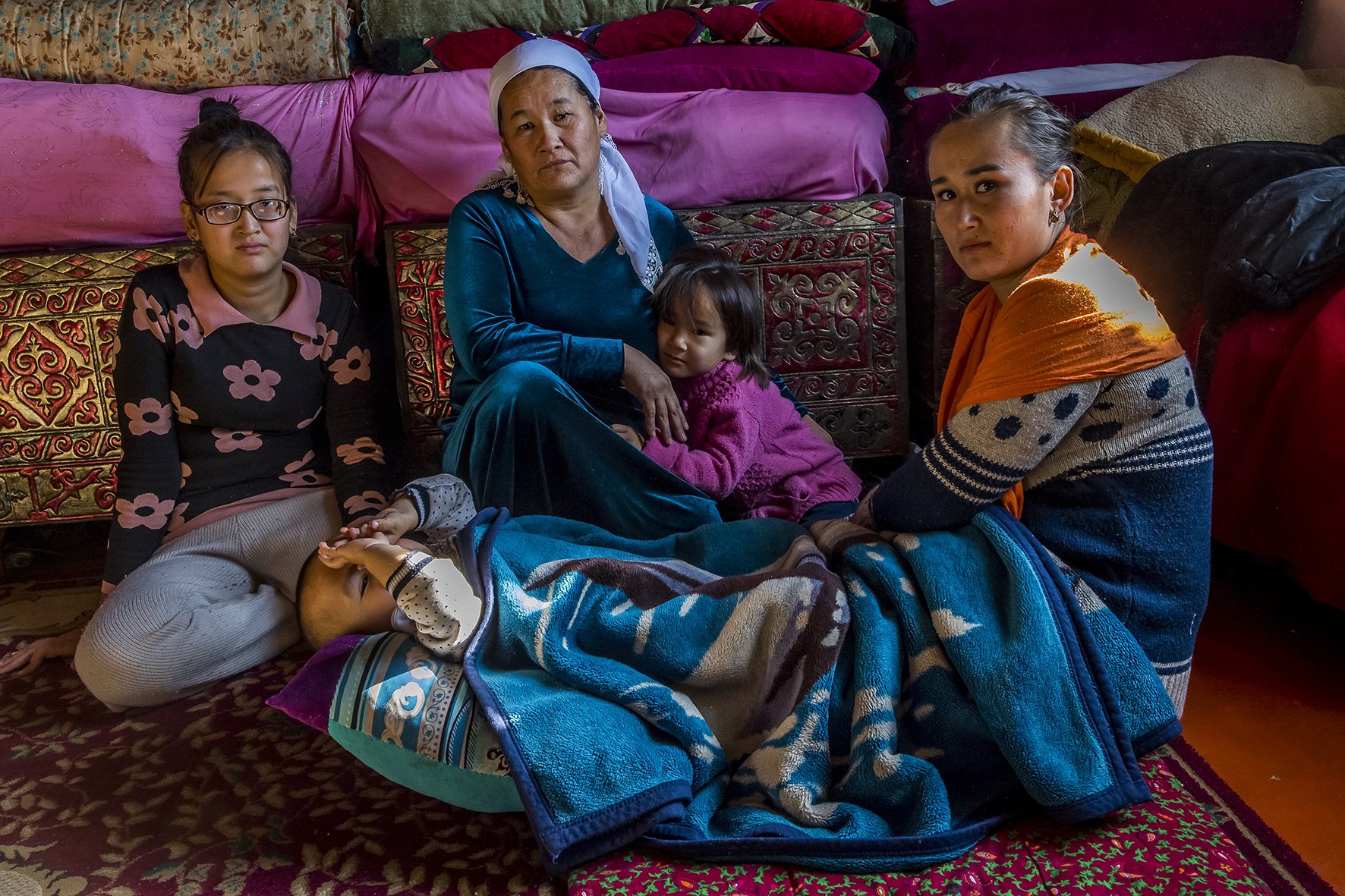
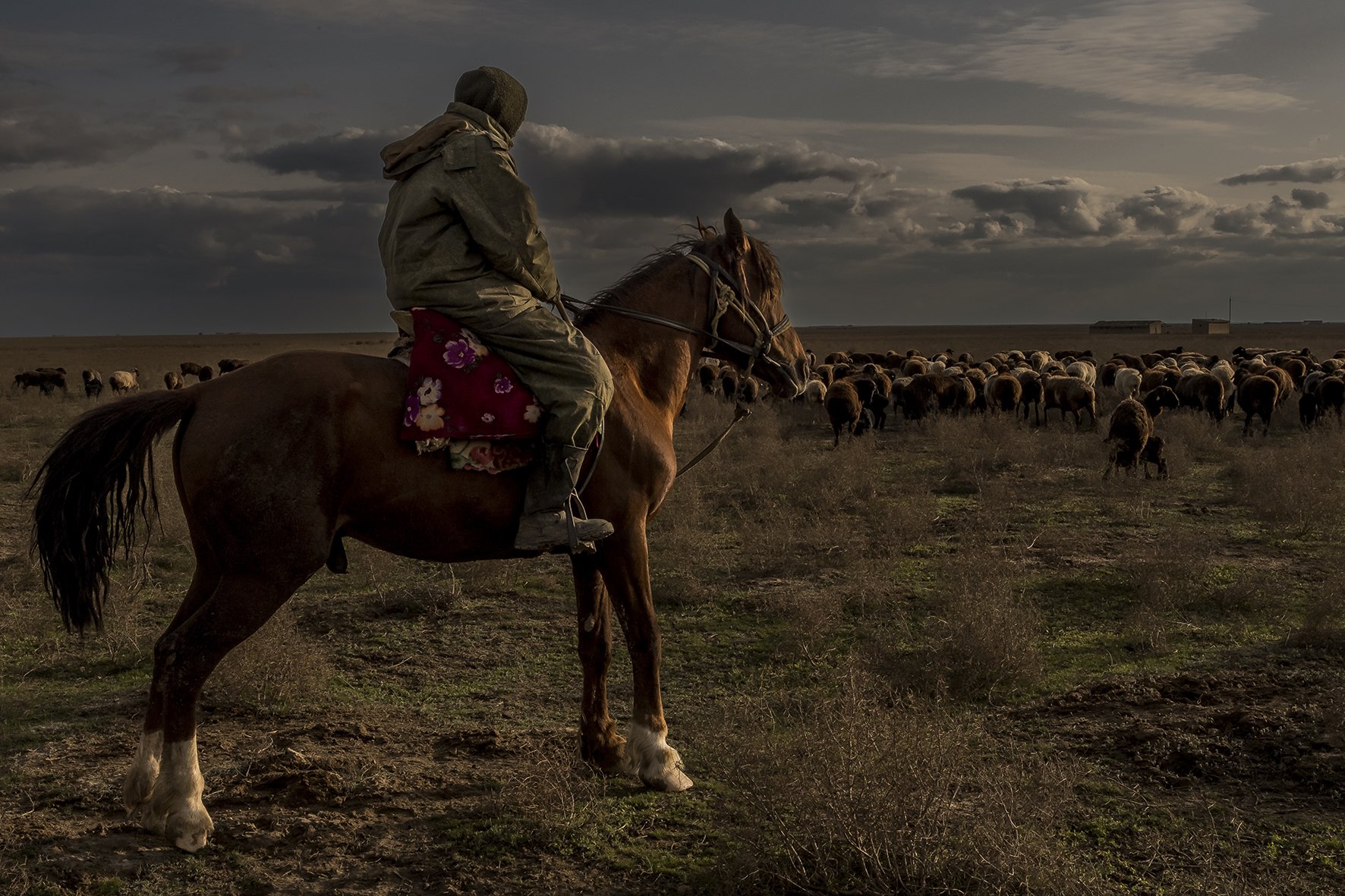


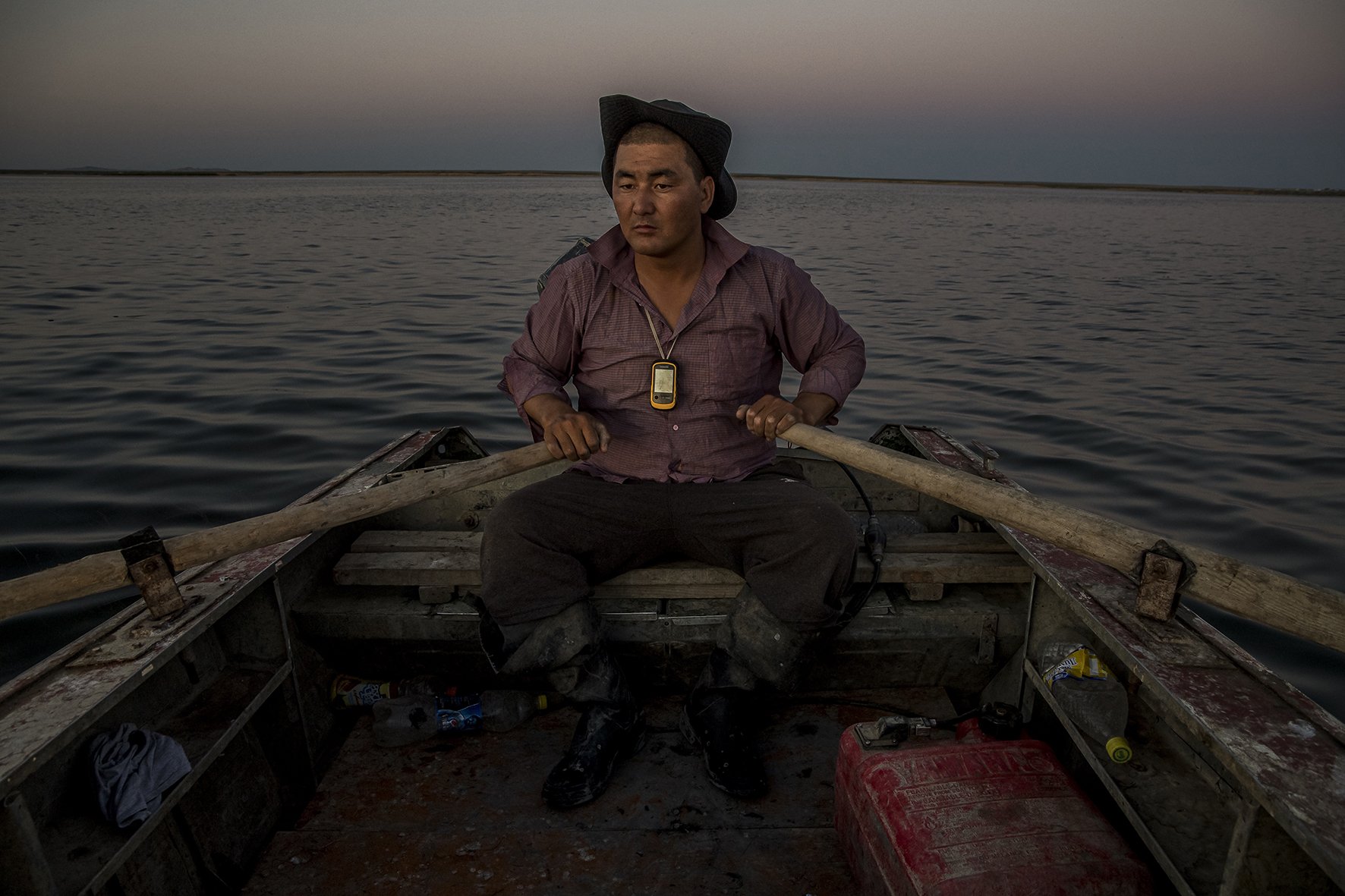
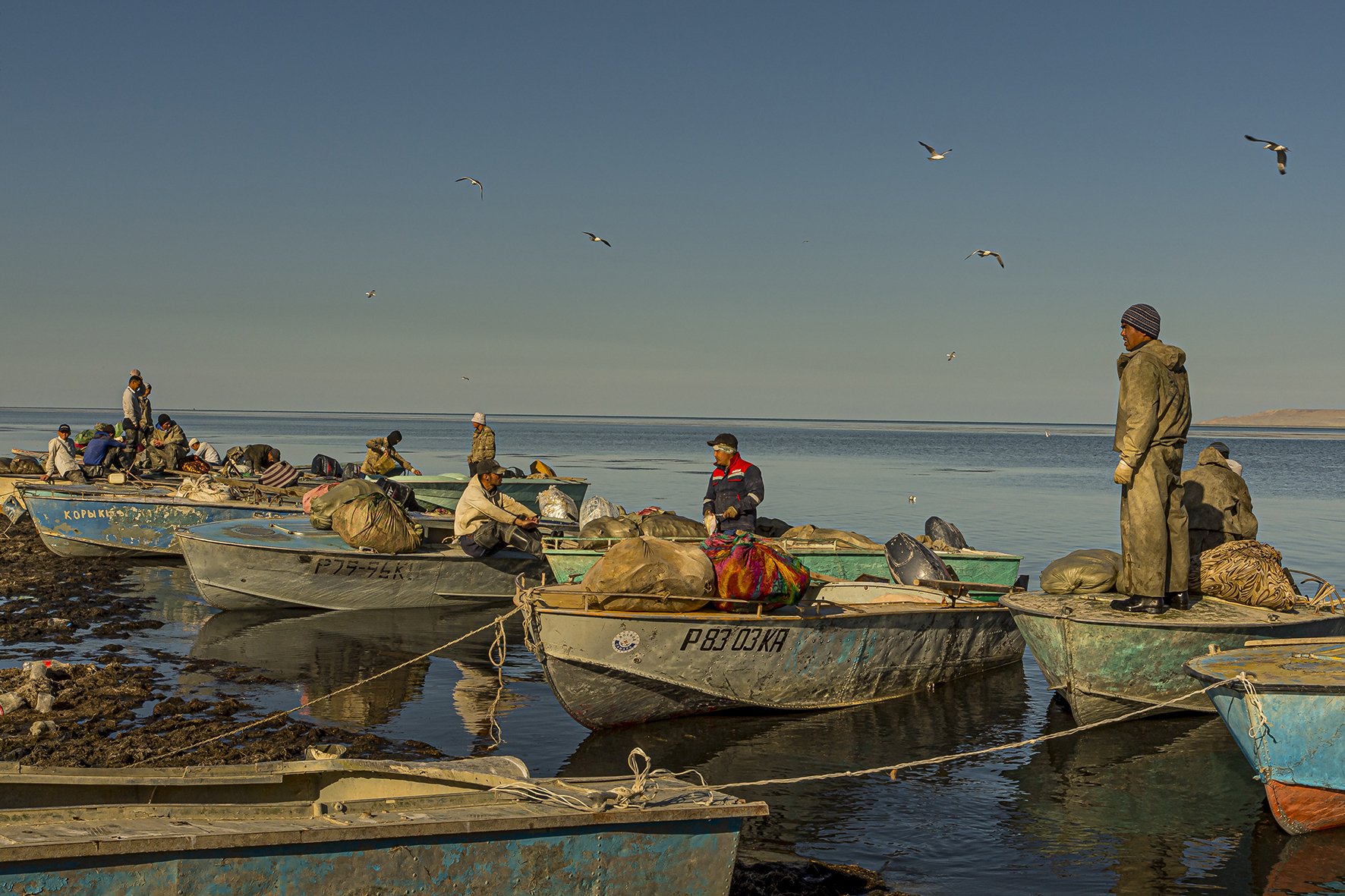


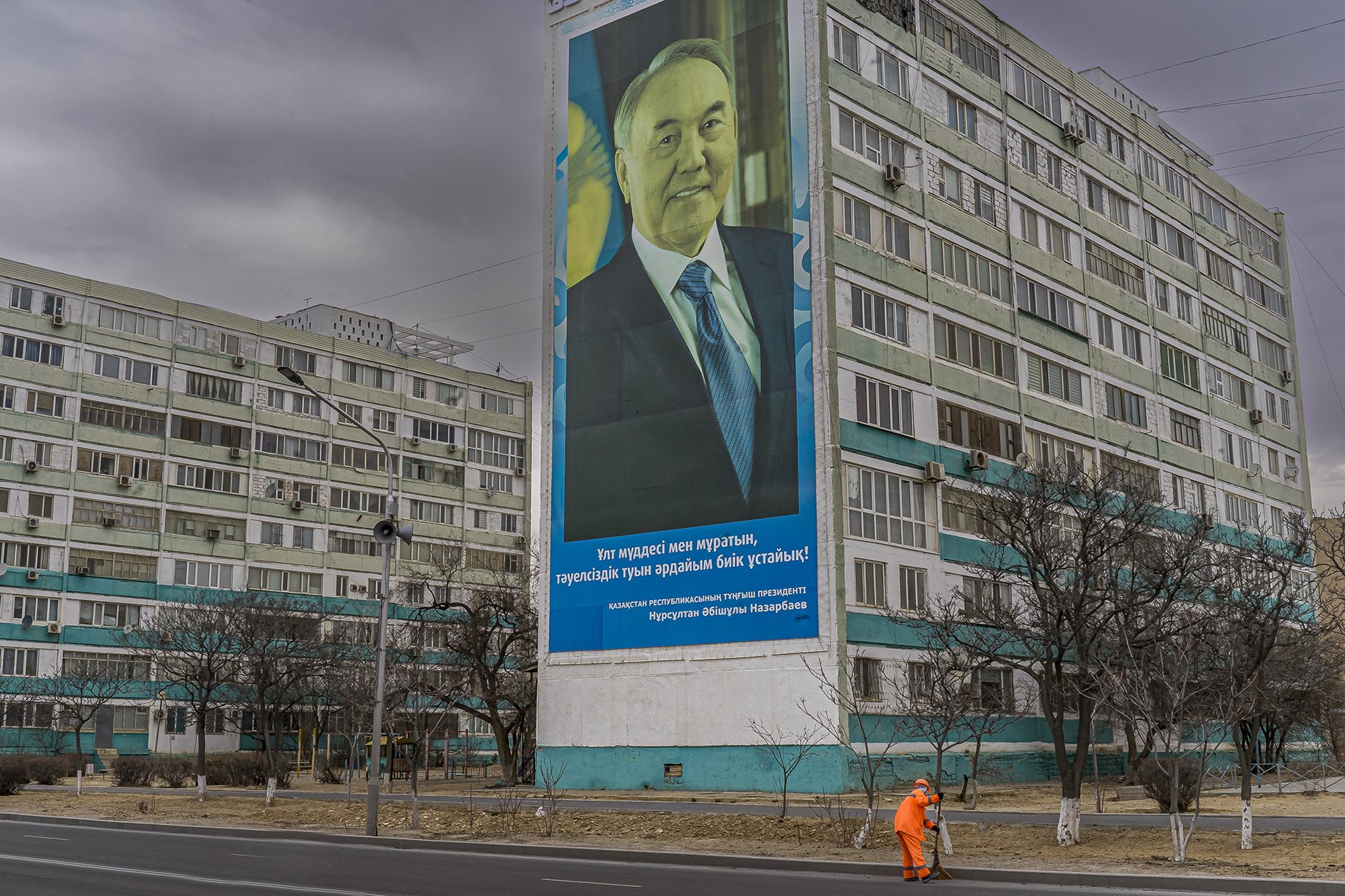
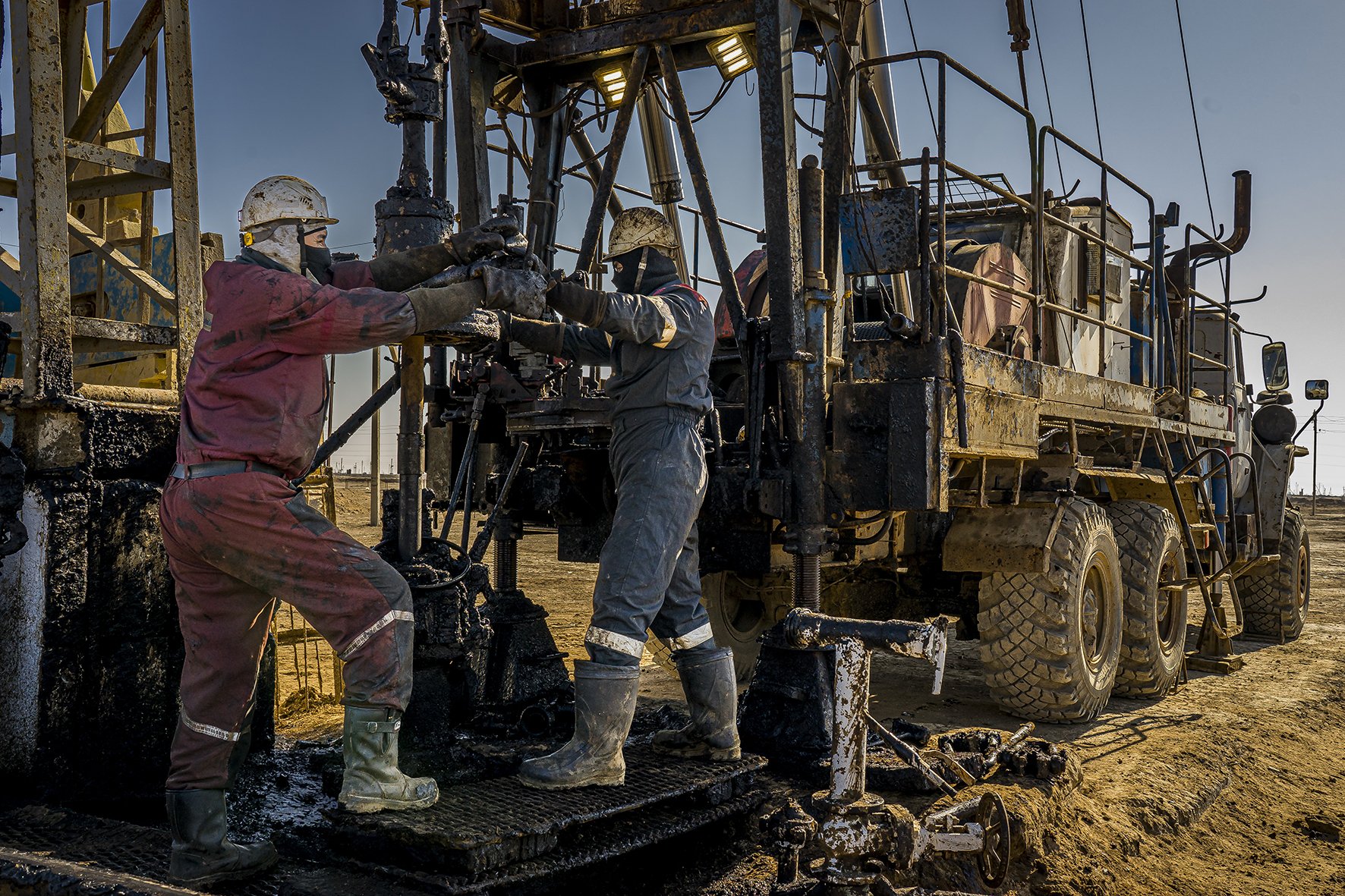

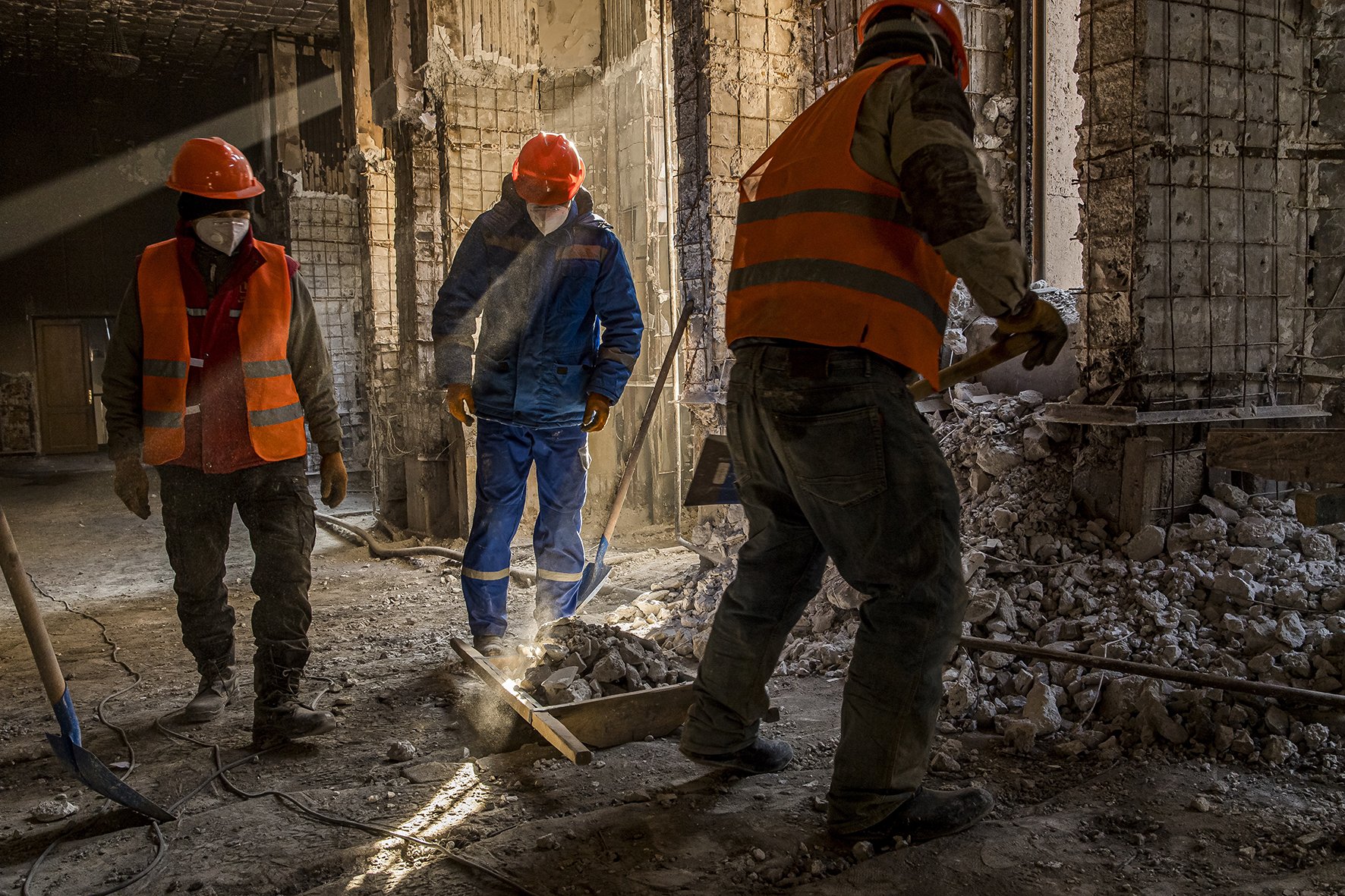


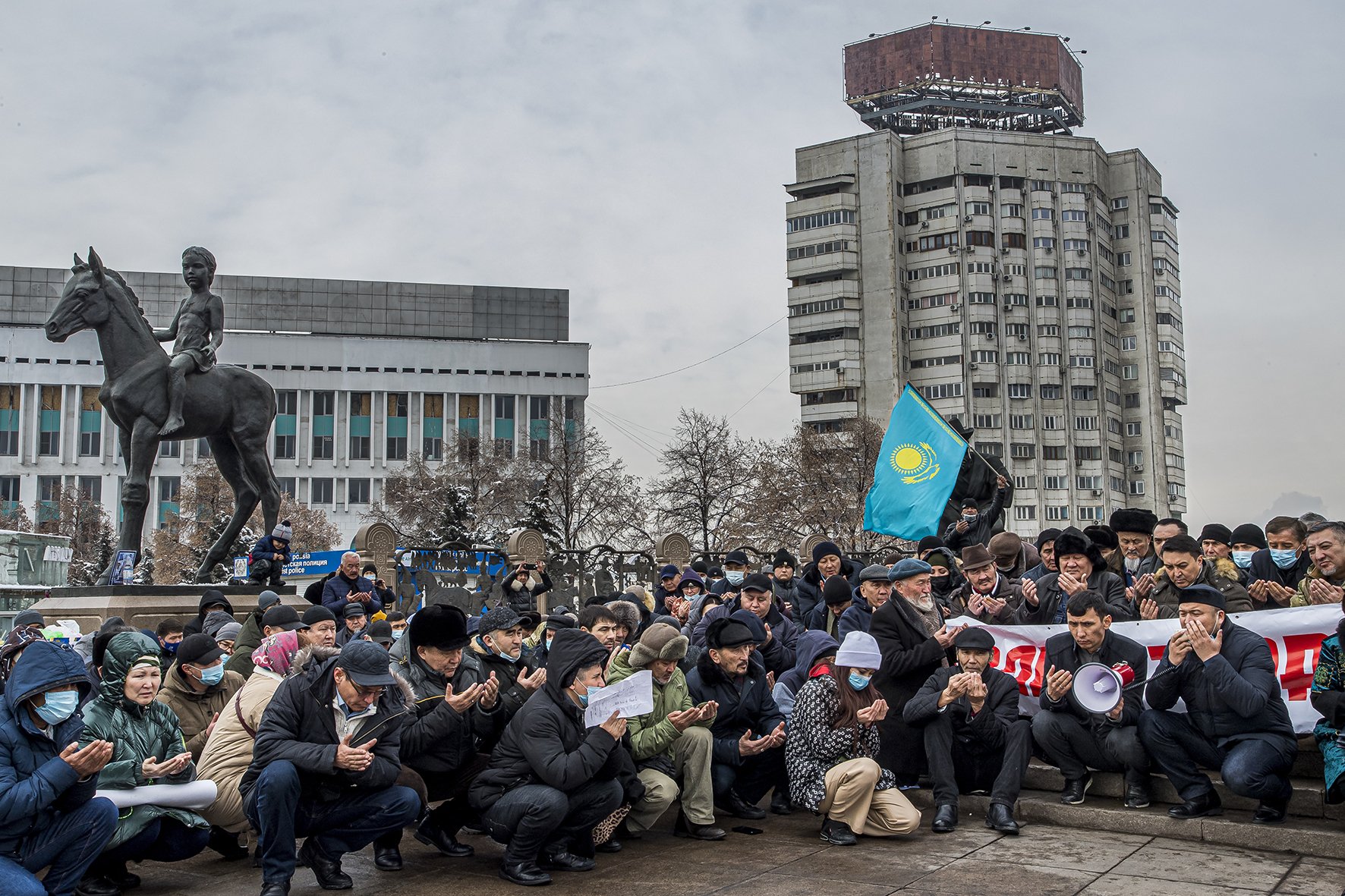
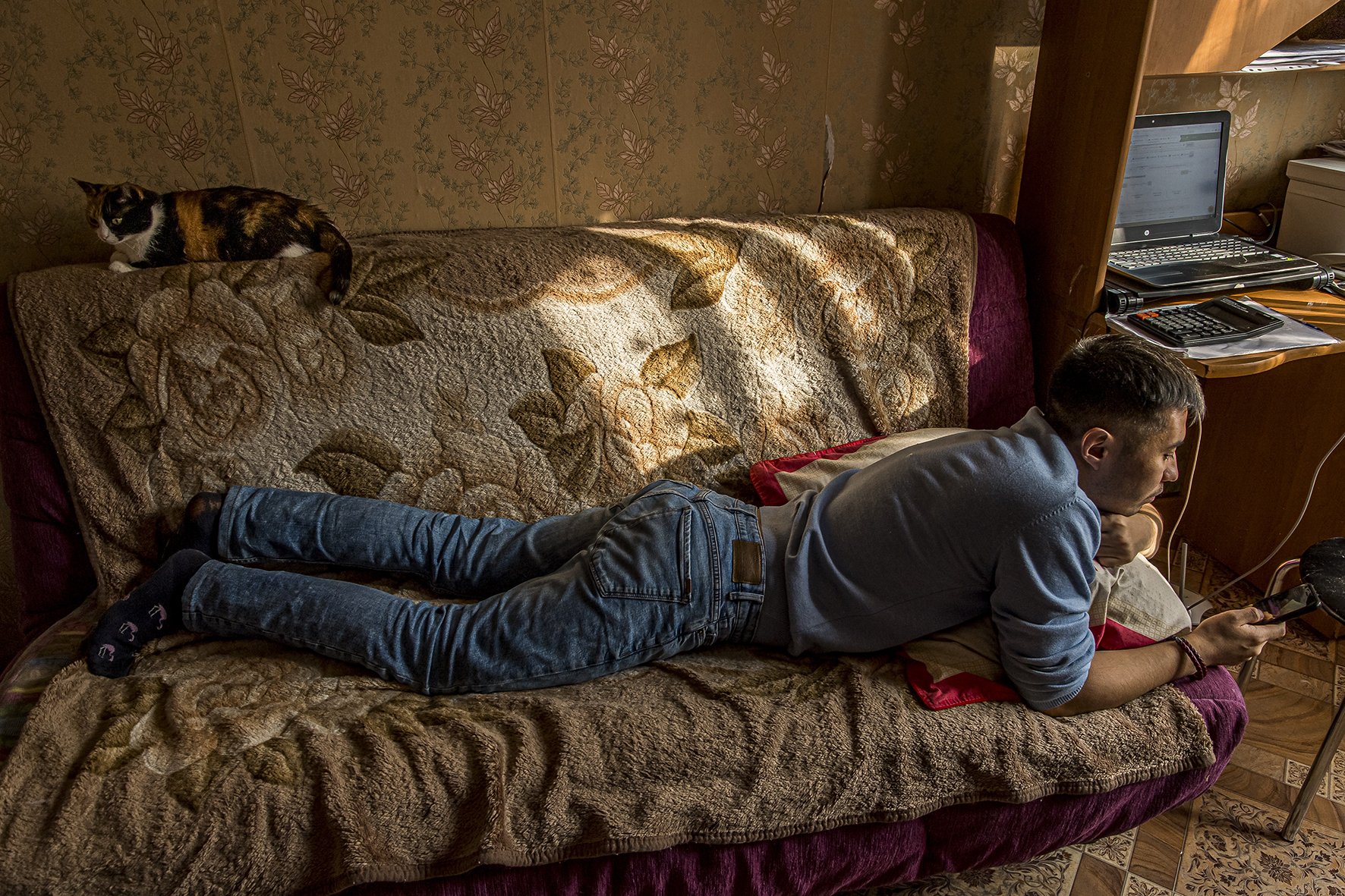





Symbole de la ville d’Astana, situé dans un quartier ultramoderne, le Palais de la paix et de la réconciliation, est une pyramide de 62 mètres de haut, qui sert de centre spirituel national non confessionnel et de lieu d'événements. Conçue par l’architecte anglais Norman Foster, avec un sommet en vitrail et des fenêtres de l'artiste architecte Brian Clarke, elle a été construite pour accueillir le Congrès triennal des dirigeants des religions mondiales et traditionnelles, et achevée en 2006.

Dans la salle panoramique installée au sommet de la tour Baïterek, des enfants apposent leur main dans l'empreinte de la paume du Premier Président Noursoultan NAZARBAYEV, gravée dans une plaque de 2 kg d'or massif. Emblème de la ville imaginé par Noursoultan NAZARBAYEV et réalisé par l'architecte anglais Norman Foster,, Baïterek (peuplier en Kazakh) est une structure de 97 mètres (année de transfert de la capitale) surmontée d’un boule dorée de 22 mètres de diamètres. L’ensemble représente le mythe du Samruk, l’oiseau magique qui, chaque année, viendrait déposer un œuf d’or au sommet d’un arbre de vie.

Générale du ballet « Notre Dame de Paris » de Rolland Petit à l’Opéra de Astana, dont l’acoustique est considérée comme l'une des meilleures au monde grâce à l’expertise d’acousticiens italiens. Parquet en hêtre et bouleau, panneaux en merisier combinés au laiton, fauteuils, miroirs et stucs décoratifs, qui reflètent ou absorbent les vibrations sonores, sont pensés et posés de manière optimum. L'angle d'inclinaison ou de rotation des chaises est le même que dans la légendaire Scala milanaise.

Dans l’Académie de ballet de Astana, des apprenties ballerines s’exercent en classe. Créé en 2015, suivant le désir de Noursoultan Nazarbaev, l’Académie nationale kazakhe de chorégraphie est le premier établissement d'enseignement supérieur d'Asie centrale à proposer un programme d'enseignement complet dans le domaine de la chorégraphie, de l'école primaire aux programmes d'études supérieures (maîtrise et doctorat). Alors qu’en période normale, des auditions sont conduites dans tout le pays, en période de Covid, les candidats doivent envoyer une video par mail.

Avant de partir en vacances d’été, des écoliers se rassemblent sous la statue d’une héroïne de guerre, pour la journée de commémoration de la 2ème guerre mondiale, à Astana. Selon Roberto J. Carmack, dans "Kazakhstan in World War II", lorsque la Grande Guerre patriotique contre l'Allemagne nazie a commencé en juin 1941, le Commissariat soviétique à la défense a mobilisé plus d'un million de personnes dans la République kazakhe, dont environ 450 000 Kazakhs de souche. Carmack estime qu'au moins 125 000 Kazakhs ont été victimes de la guerre (morts, blessés ou disparus).

Une chanteuse de la chorale de l’Armée Kazakhstanaise lors de la réalisation d’un clip video, sous une fresque commémorant le courage de l’Armée Rouge pendant la seconde guerre mondiale. Le clip sera diffusé sur les réseaux sociaux le lendemain, le 9 mai, lors du jour de Victoire, jour choisi en Union Soviétique.

Commémoration du jour de la victoire à Astana, le 9 mai, au pied du monument aux morts à la gloire des héros de la seconde guerre mondiale.

Un des 16 derniers anciens combattants de l’Armée Rouge vivant dans la capitale Noursoultan. Durant la Seconde guerre mondiale, il fut en poste à Vladivostok.
Selon Roberto J. Carmack, dans "Kazakhstan in World War II", lorsque la Grande Guerre patriotique contre l'Allemagne nazie a commencé en juin 1941, le Commissariat soviétique à la défense a mobilisé plus d'un million de personnes dans la République kazakhe, dont environ 450 000 Kazakhs de souche. Carmack estime qu'au moins 125 000 Kazakhs ont été victimes de la guerre (morts, blessés ou disparus).

Dans la steppe proche de la capitale Astana, des kokparshy, joueurs de Kokpar, s’affrontent dans une mêlée indescriptible pour saisir un corps de chèvre sans tête. La version communale de ce jeu voit jusqu'à 200 ou 300 joueurs s’affronter et chacun jouer pour lui-même. Les tribus qui descendent de Gengis Khan ont répandu leur culture dans toute la Mongolie et l'Asie centrale, mais nul part dans cette région le contraste entre le contemporain et l'ancien n'est plus élevé qu'au Kazakhstan. Et l'interaction entre les deux n'est nulle part aussi clairement incarnée que dans le kokpar.

Dans la steppe proche de la capitale, après une longue session de Kokpar par une après-midi estival étouffante, des kokparshy, joueurs de Kokpar, se changent avant de rentrer chez eux en voiture. Ils ôtent les lourdes bottes rigides montant au dessus du genou, les protections en mousse ainsi que les deux pantalons qu’ils portent.

Des écoliers au garde à vous pendant la cérémonie de fin d’année scolaire dans un établissement publique d’Astana.

Clôturant la cérémonie « Posledni Zvonok » (dernière cloche de l’école), symboliquement, des couples d’étudiants arpentent une dernière fois la cour en faisant sonner une clochette, synonyme de début des cours tout au long de l’année. La période des examens commencent, puis les grandes vacances.

Dans le quartier de Prigorodny, constitués de datchas, un faubourg de Astana près de l’aéroport, une sage-femme à la retraite récolte des légumes de son jardin. 10 à 15.000 personnes, soit 2.500 familles habitent le quartier aux beaux jours. La reprise du chantier tout proche du LRT, un métro aérien devant relier la ville à l’aéroport situé à proximité, fait craindre aux habitants une prochaine expulsion. Les datchas ne sont pas officiellement enregistrées. Les propriétaires sont en sursis depuis des années.

Maria, 4 ans, la fille aînée de Victoria, une jeune kazakhstanaise d’origine russe de 28 ans, se réfugie dans le lit de son jeune frère Daniil. La mère et ses deux enfants se sont réfugiés. Elle loue une chambre dans un appartement d’un quartier populaire de Astana, après que son compagnon violent et alcoolique l’ait expulsée de leur domicile.

A Astana, des collégiennes discutent sur le pont d’Atyrau, nommé ainsi car offert par la région pétrolière d'Atyrau à la capitale à l'occasion de son 20ème anniversaire. C’est « Posledni Zvonok » (dernière cloche de l’école), le dernier jour avant les vacances. Comme le veut la tradition ce jour-là, elles portant le tablier et les rubans, éléments de l’uniforme traditionnel des collégiens au temps de l’Union Soviétique, souvent porté par leur mère.

Astana, Kazakstan. A l’appel de SOS Taldykol, un groupe d’initiative citoyenne qui se bat pour préserver les lacs Taldykol Maliy, menacés de disparition à cause d’un projet de construction à la périphérie de Astana, de jeunes volontaires, nettoient les rives du lac Taldykol où des tonnes de déchets de construction et d’ordures ménagères sont déposés régulièrement dans la plus parfaite illégalité.

De jeunes kazakhstanaises d’origine allemande dansent pendant le spectacle de fin d’année tenu dans leur centre communautaire à Astana. Ces Aussiedler sont les descendants de colons allemands établis en Europe de l'Est et en Russie aux siècles précédents, surtout dans les années 1760, à l'invitation de Catherine II, pour exploiter la Volga. En 1941, suspectés de collaboration avec les nazis, beaucoup de ces «Allemands de la Volga» furent déportés par Staline vers la Sibérie ou le Kazakhstan et soumis à une assimilation culturelle imposée dans la culture russe.

Cimetière des Mères du Karlag, abréviation de KARaganda gouLAG, dans le village de Dolinka, dans la steppe kazakh au centre du pays. Il était principalement utilisé pour les bébés nés au Karlag et leurs mères. Aucune interaction n'était autorisée entre prisonniers homme et femme, sauf dans des situations supervisées. Il était quasi impossible qu’un enfant soit conçu. Cette situation s’est néanmoins produite, car certaines prisonnières arrivaient au camp enceintes ou « tombaient enceintes » de gardiens. Dolinka fut le siège de la direction du Karlag, géré par le NKVD, l'ancêtre du KGB. Construit sous Staline, à l’époque des répressions politiques de masse en Union soviétique dans les années 1930, il couvrait 60 000 km2, et était divisé en plusieurs camps. Les camps du Karlag ont fonctionné de 1931 à 1959 avec un pic d'environ 65 000 prisonniers en 1949.

Usine sidérurgique d’Arcelor Mittal à Termitau, anciennement Karmet. En janvier 2018, plusieurs sources ont rapporté le phénomène de la " neige noire " tombant sur Temirtau. Les résidents de la ville et de la région de Karaganda ont recueilli des signatures pour demander à Aliya Nazarbayeva, la fille cadette de l’alors président Nursultan Nazarbayev et chef de l'Association des organisations écologiques du Kazakhstan d'enquêter et d'infliger une amende à ArcelorMittal Temirtau. En décembre 2017, ArcelorMittal Termitau a reconnu la relation possible entre la pollution de l'usine et la neige noire, déclarant que "les émissions ne se dissipent pas et cela a très probablement causé le changement de couleur de la neige ».

Nouveau quartier en cours d'expansion et de construction dans la ville de Karaganda, la quatrième plus grande ville du Kazakhstan avec une population proche d'un demi-million d'habitants. Le nom de Karaganda est souvent utilisé de manière ironique dans d'autres régions de l'ancienne Union soviétique, pour désigner « le milieu de nulle part ». La présence d'une grande zone urbaine à cet endroit est due à la présence de charbon qui a été exploité à partir des années 1850, mais qui n'est devenu une industrie majeure que dans les années 1930, lorsque les autorités soviétiques ont décidé d'utiliser les réserves de charbon de Karaganda pour alimenter l'industrie de l'Oural. L'accomplissement de cette tâche a été réalisé grâce au travail des déportés et Karaganda est devenue célèbre pour sa forte concentration de camps de travail, dont beaucoup sont regroupés dans une grande zone au sud-ouest de la ville, connue sous le nom de KARLAG.

Dans la ville d’Abay, proche de Karaganda, l’école de boxe d’Abay. C’est une région ouvrière de boxeur traditionnellement. Dans cette école s’est entraîné Serik (Zhumangaliyevitch) Sapiyev, boxeur kazakh né le 16 nov. 1983 à Abay. Médaille d'or aux championnats du monde en 2005 et 2007, catégorie super-légers puis boxe dans la catégorie supérieure. Il décroche alors la médaille d'argent aux championnats du monde 2009 et 2011 et le titre olympique à Londres en 2012.

Kayrakty, une ville fantôme, anciennement minière. A son apogée, elle abritait un cinéma, des écoles, des magasins.

Durant le mois de juillet, particulièrement torride comme tous les mois d’été dans le Kazakhstan central, des touristes se prélassent sur la plage publique de Balkach, la cité balnéaire des bords du lac de même nom.

Priozersk, une ville dont une partie est toujours utilisée par l’armée russe pour des test et recherches balistiques.

« Prolétaires de tous les pays, unissez-vous ! » Le professeur de sport de la petite école de Mirny pose au guidon de son side-car Uralsk au pied d’une fresque soviétique récemment rénovée, personne ne sachant trop par qui… Situé dans le sud du pays, dans la région de Zhambyl, Myrny était autrefois un des sites les plus prometteurs de la région de Moiynkum. Selon les résidents locaux, il est apparu sur la carte du Kazakhstan à la fin des années 50. Cette colonie a été construite par des prisonniers qui purgeaient leur peine dans une prison voisine. ll y avait un site d’extraction d’uranium à 11 kms de là. 5.000 habitants à l’époque. Aujourd’hui 674 personnes dont 70% âgés.

Campus de Kaznu, l'Université nationale kazakhe Al-Farabi, à Almaty, nommée d'après le philosophe et savant oriental al-Farabi. C’est l'une des plus grandes universités du pays et la plus ancienne université classique de la République, créée par un décret du bureau du Comité régional kazakh le 13 novembre 1933.

Durant un cours d’autodéfense, dans un gymnase d’Almaty, Maria Makatrevich, championne nationale kazakhe de boxe et de kickboxing, ancienne garde du corps de riches homme d’affaires enseigne à de jeune femmes à se défendre lors d’une agression, notamment en cas de violence domestique, un problème grave au Kazakhstan. Chaque année, des centaines de femmes fuient leur partenaire violent, leur mari ou d'autres membres de leur famille et cherchent de l'aide et un refuge dans les quelques « centres de crise » du pays. Le faible pourcentage d'affaires portées devant les tribunaux s'explique par le fait que la majorité de la population partage généralement une vision patriarcale de la violence domestique, considérée comme une question familiale privée plutôt que comme une violation des droits humains. Les victimes subissent des pressions de leurs proches pour ne pas porter plainte et se réconcilier avec leurs agresseurs.

Almaty, sud du Kazakhstan. Depuis de nombreuses années, selon les chiffres du ministère de l’écologie, la pollution atmosphérique est élevée à Almaty notamment à cause de la combustion de charbon de mauvaise qualité dans les centrales thermiques. Les habitants ont 20% plus de chance d’avoir une maladie respiratoire, 40% des maladies endocriniennes et 50% des tumeurs que dans le reste du pays.

Plus grande station de ski d'Asie centrale, Shymbulak, proche de Almaty, située à 2 200 mètres d’altitude, est populaire auprès de la frange urbaine, occidentalisée et relativement aisée de la société kazakhstanaise. Elle a été découvert par des skieurs amateurs dans les années 1940, avant de devenir la première piste de descente de l'Union soviétique. De nombreux touristes étrangers visitent la station chaque saison. Sur les 800 000 visiteurs annuels, 30 % viennent de l’étranger.

L’eucharistie durant le service dominicale dans la cathédrale orthodoxe russe de l'Ascension, également nommé Zenkov du nom de son architecte, situé dans le parc Panfilov à Almaty. Les orthodoxes représentent 21,4 % de la population du pays. Construite entre 1904 et 1907, elle possède la particularité d'avoir été construite entièrement en bois et sans aucun clou. Confisquée par l'état et transformée en musée durant la période soviétique, elle est redevenue un lieu de culte orthodoxe en mai 1995, quelques années après l’indépendance.

Des cadets se promènent dans le parc Panfilov à Almaty, devant le monument en hommage aux mythiques 28 hommes du General Ivan Vasilyevich Panfilov. Ce général est un Héros de l'Union soviétique à titre posthume. La légende veut que ces 28 hommes aient sauvé Moscou de l’offensive nazie durant la seconde guerre mondiale.

Fans du groupe Ninety one durant un concert à Almaty. Dans la société kazakh corsetée, leurs apparence a révolutionné la représentation du genre, révolté les conservateurs et booster l’utilisation du kazakh dans la chanson contemporaine.

Un chauffeur de l’équipe de fouilles sur une basse montagne surplombant le campement de fouilles, au matin, dans la vallée d’altitude de Eleke Sazy (à droite) et le lieu de fouilles (à gauche).

Tombe d’un guerrier enterré avec son cheval sur le site de fouilles de Berel. Les montagnes de l'Altaï forme un amphithéâtre naturel, tandis qu’une large terrasse de la rivière Bukhtarma sert de scène à une centaine de kourganes (tumulus funéraires) à Berel. Depuis 1998, les fouilles menées par le professeur Zainolla Samashev ont mis au jour des vestiges spectaculairement préservés, datant du IVe siècle avant J.-C. au VIIe siècle de notre ère.

Une guide expliquent à des touristes le sens et la valeur de la structure muséale reconstituant un tombeau à partir de résultats de fouilles, dans le complexe-musée historique et culturelle de "Berel" située dans la région de Katon-Karagay près du village du même nom Berel, à 450 kilomètres d'Ust-Kamenogorsk.

Fouilles sur le site de Eleke Sazy. C’est une vaste vallée en forme de coupe entourée de basses montagnes. Établis sur les hauteurs dans un paysage en mosaïque de rivière, de marais et de steppe, se trouvent plus de 300 kourganes (tumulus construit sur une tombe, souvent caractérisé par le fait qu'il contient un seul corps humain ainsi que des objets funéraires, des armes et des chevaux), dont certains datant de la plus ancienne période Saka (9e siècle avant notre ère). Les fouilles menées par le professeur Zainolla Samashev (Université Nazarbayev) ont commencé en 2018 et se poursuivent.

Entrée du village de Verkhnyaya Beryozovka aka Қайынды, un hameau le long de la rivière Boukhtarma, dans les environs du village de Berel, situé dans la région de Katon-Karagay, à 450 kilomètres d'Ust-Kamenogorsk. A Berel est situé la réserve /musée historique et culturelle.

La directrice du musée ethnographique régional du Kazakhstan oriental, à Oskemen (Ust-Kamenogorsk).

Un groupe de femmes pendant leur cours de gymnastique dans le parc Zhambyl à Oskemen (Ust-Kamenogorsk).

Promenade familiale dans l’allée des statues de Lenine dans l’Ethno parc de Oskemen (Ust-Kamenogorsk).

Près du ville d’Ungurtas, dans la région de Almaty, Saltana, disciple d’une chamane âgée, sonne la cloche sur la montage de l’Amour pour prévenir les esprits de sa présence. Cette colline réputée d’après-elle, pour son fort rayonnement magnétique, fait face à la chaine de montage Zahilisk, entre Kirghizistan et Kazakshtan.

Accompagné par les maîtresses de cérémonie en costumes d’aparat et de danseuses, des mariés entrent dans la salle de réception louée pour l’occasion dans la banlieue de Chymkent. Malgré les années de marasme économique traversées par le Kazakhstan, la mode des fêtes grandioses et dispendieuses ne faiblit pas jusqu’à inquiéter, en 2019, l'ancien président Nursultan Nazarbayev qui appela alors ses concitoyens à dépenser moins en fêtes et à investir davantage dans le logement.

La raison de cette inquiétude est que beaucoup de personnes qui ne peuvent pas se permettre les dépenses d'un mariage contractent souvent des prêts. Les banques font même de la publicité pour des crédits spéciaux sur le thème du mariage, qui permettent d'emprunter jusqu'à 15 000 dollars à un taux d'intérêt annuel de 15 % pendant cinq ans sans fournir de garantie.

Dans le gymnase de l’école du village de Beinetkech, un repas réunit toute la population pour Naouriz, la fête célébrant l’avènement du printemps. Suivant la tradition, l’hôte offre une tête de bélier cuite, un morceau de choix, à l’invité d’honneur, le doyen du village. Ce dernier en découpe des morceaux, puis la fait circuler.

Dans le village de Beinetkech, au bout de la très longue et riche dastarkhan (table basse du repas) dressée pour Naouryz, la fête du printemps, les femmes de la famille plaisantent et discutent.

La famille « Qandas » de Zukhra Mukanova (foulard bleu), dans le salon familial, village de Chubarsu, proche de Chymkent. Le terme Qandas signifie littéralement de même sang et a remplacé le mot Oralman (les retournés) utilisé auparavant pour désigner les Kazakhs de souche revenus au pays. Le Président Tokaïev a pris cette décision pour éviter toute politisation ou stigmatisation de la question des rapatriés apatrides. Les « Qandas » sont des descendants de Kazakhs ayant fui le régime soviétique à partir de 1920 et résidant le plus souvent dans d'autres États d'Asie centrale.
Zukhra est rentré d'Ouzbékistan en 2010 avec ses filles. Bien qu'elle ait un permis de séjour, elle a entamé des démarches pour obtenir la citoyenneté afin que ses filles mineures deviennent automatiquement kazakhstanaises et bénéficient des droits afférents.

Dans les environs de Turkestan, en fin de journée, un berger ramène son troupeau de moutons vers l’étable.

Un couple de Kazakhs en route pour Kyzylorda depuis Almaty (23 heures de trajet) se sont installés dans leur compartiment. Le train reste le mode de transport des classes les moins favorisées par le boom économique au Kazakhstan. Les distances entre les villes sont très grandes et il faut des heures pour se rendre de l’une à l’autre.

Dans le hall d’attente de la gare de Aralsk, une grande mosaïque murale commémore un épisode glorieux des pêcheurs de la Mer d’Aral : la contribution de la ville, qui fournit 14 wagons de poisson lorsque la famine frappa la Russie durant les premiers temps tumultueux de l’URSS. Depuis les projets d’irrigation d’immenses champs de coton d’Asie Centrale au moyen des affluents de la mer d’Aral les ont asséché et ont fait reculer la mer dont la ville n’est plus riveraine.

En fin de journée, au large du village de Tastubek, sur la mer d’Aral, Nurjan, un pêcheur pagaie lentement pendant que son assistant jette des filets. Ils seront relevés le lendemain matin, à l’aube.

Pendant de nombreuses années, l'Aral n'a donné à ces hommes aucune raison de se réjouir. La pêche s'est éteinte dans les années 1980, après que le gouvernement soviétique a drainé la mer pour alimenter les champs de coton très loin en amont. Autrefois colossale, la mer d'Aral a rétréci pour ne plus contenir qu'un dixième de son volume d'origine, devenant l'ombre tragique d'elle-même. Ses poissons sont morts, les pêcheurs les plus performants sont partis. Grâce à la construction d’une digue financé par la Banque Mondiale, la partie nord de la mer s’est suffisamment rempli pour voir le retour de poissons.

Après les mois d’hivers passés principalement en écurie, aux premiers jour du printemps, dans la steppe kazakh, les chevaux sont laissés en liberté pour paître librement. Les montures les plus rétives ou les plus précieuses voient leur membres antérieurs entravées.

Lors d’une séance photo pour le projet d’un artiste Kazakh, la comédienne Almira Tursyn, tient dans ses bras un bébé saigua de quelques heures, un spécimen d’une rare espèce d’antilope eurasiatique, vivant principalement dans les steppes du Kazakhstan. Psychologue de formation et elle a été choisie parmi 15.000 candidats pour incarner Tomyris, reine légendaire de la steppe.

Plusieurs semaines après les évènements de janvier 2022 qui ont officiellement causés la mort de 227 personnes et la fin de l’ère du clan Nazarbaev, l’immense portrait de Elbassy (le Père de la Nation en kazakh), est toujours solidement fixé à un immeuble sur le front de mer, à Aktau, au bord de la Caspienne. « Gardons haut le drapeau de l’indépendance, l’intérêt de la nation et son but », clame-t-il…

A Zhanaozen, des ouvriers de maintenance réparent une pompe d’extraction de pétrole. C’est de cette ville pétrolière, symbole de la lutte pour la justice sociale au Kazakhstan que les manifestations de janvier ont démarrées, avant de s’étendre à la plupart des régions du pays. Depuis de nombreuses années, les riverains se battent pour améliorer leur situation et développer la ville. Mais, malgré les protestations et l'impressionnante production pétrolière, la ville a toujours des problèmes de chômage, de logement, d'infrastructures et, surtout, d'avenir. Les 156.000 habitants de l’agglomération de Zhanaozen s'inquiètent de ce qui arrivera à la ville lorsque le pétrole s'épuisera ici.

Un ouvrier en charge du nettoyage, avant la restauration de l’hôtel de ville d’Almaty, passe devant l’entrée calcinée de l’auditorium et du grand escalier. Epicentre des émeutes du début de l’année 2022 au Kazakhstan, il fut pris d’assaut par une foule et incendié le 5 janvier. L’épave calcinée était le siège du pouvoir dans la plus grande ville du pays. Ancien siège du comité central du parti communiste durant la période soviétique, inauguré en 1980 , cet édifice massif domine la ville depuis sa position élevée, surplombé par les majestueuses montagnes de l'Ile-Alatau. Sa reconstruction rapide est une priorité pour prouver la reprise de contrôle par le pouvoir et le retour à la normale.

Des ouvriers déblaient les gravas et déshabillent, jusqu’à sa structure métallique, l’Akimat, le monumental hôtel de ville de Almaty. Epicentre des émeutes du début de l’année au Kazakhstan, il fut pris d’assaut par une foule et incendié le 5 janvier. L’épave calcinée était le siège du pouvoir dans la plus grande ville du pays. Ancien siège du comité central du parti communiste durant la période soviétique, inauguré en 1980 , cet édifice massif domine la ville depuis sa position élevée, surplombé par les majestueuses montagnes de l'Ile-Alatau. Sa reconstruction rapide est une priorité pour prouver la reprise de contrôle par le pouvoir et le retour à la normale.

Dans les environs de Almaty, Dauren Bitkembayev sur la tombe de ses parents, Gulzifa, enseignante à la retraite, et Kuat, ancien militaire et postier à la retraite, vraisemblablement abattus en ville alors qu'ils rentraient tard chez eux, en voiture, après une réunion de famille, durant les évènements de janvier 2022.

Dimanche 13 février 2022, malgré l'interdiction officielle de la commémoration, des personnes se rassemblent sur la place de la République à Almaty, en mémoire des victimes des violences de janvier, 40 jours après que la mort ait frappé, comme le veut la tradition. Environ 350 personnes sont présentes, tandis que la police garde ses distances.

Dans une manifestation non autorisée dans le centre d'Almaty, la plus grande ville du Kazakhstan, le 13 février 2022, des centaines de personnes prient, afin d'honorer la mémoire des personnes tuées lors des manifestations de janvier. Les participants demandent que le président Qasym-Zhomart Toqaev soit destitué et que l'ancien président Nursultan Nazarbaev soit jugé pour leur rôle dans la répression des manifestations.

Comptable indépendant, un membre d'Oyan Qazaqstan (OQ) " Réveil toi, Kazakhstan ", écrit sur les médias sociaux depuis chez lui. OQ est un mouvement de défense des droits civiques fondé en 2019 à Almaty dont le nom est basé sur un livre de poésie écrit par Mir Yakub Dulatov, un poète kazakh et un dirigeant du gouvernement nationaliste kazakh Alash Orda, en 1909.

Le 8 mars 2022, plus de 1 000 personnes se rassemblent à Almaty pour marquer la Journée internationale de la femme et réclamer l'égalité des droits. Les militantes demandaient au Gouvernement de définir des politiques plus modernes en matière de genre, de réduire l'âge de la retraite de 63 à 58 ans, d'adopter des mesures visant à mettre fin aux violences domestiques et d'embaucher davantage de femmes dans les organes publiques et les structures gouvernementales.

Sur la route entre Kostanay et Astana, deux copains font une pause en consultant les réseaux sociaux. Le 15 septembre 2021, la chambre basse du parlement a approuvé un projet de loi visant à protéger les droits des enfants en prévoyant notamment de réglementer les médias sociaux et les contenus numériques afin de lutter contre le cyberharcèlement et le suicide des adolescents. Certains pensent qu’en fait de protection, il s'agit surtout d'une tentative de contrôle des créateurs de contenu et des blogueurs. Au Kazakhstan, plus de 45 % des 19 millions de citoyens utilisent les médias sociaux au moins une fois par semaine pour obtenir des nouvelles et des informations.

Des dizaines de jeunes, d’activistes et de membres de la société civile, sensibles aux causes queer et féministes se retrouvent dans une des deux seules boîtes de nuit LGBT friendly de Almaty, durant une after party, à la suite d’une manifestation.

En une fin d’été, dans un parc de la ville de Shymkent, des pédalos en forme de cygnes attendent des clients.